Why Honesty is the Best Policy in Paying Taxes: An Analysis of Tax Compliance
VerifiedAdded on 2019/12/28
|19
|5326
|69
Essay
AI Summary
Every citizen has to pay taxes honestly by filling an accurate taxation return.
Contribute Materials
Your contribution can guide someone’s learning journey. Share your
documents today.
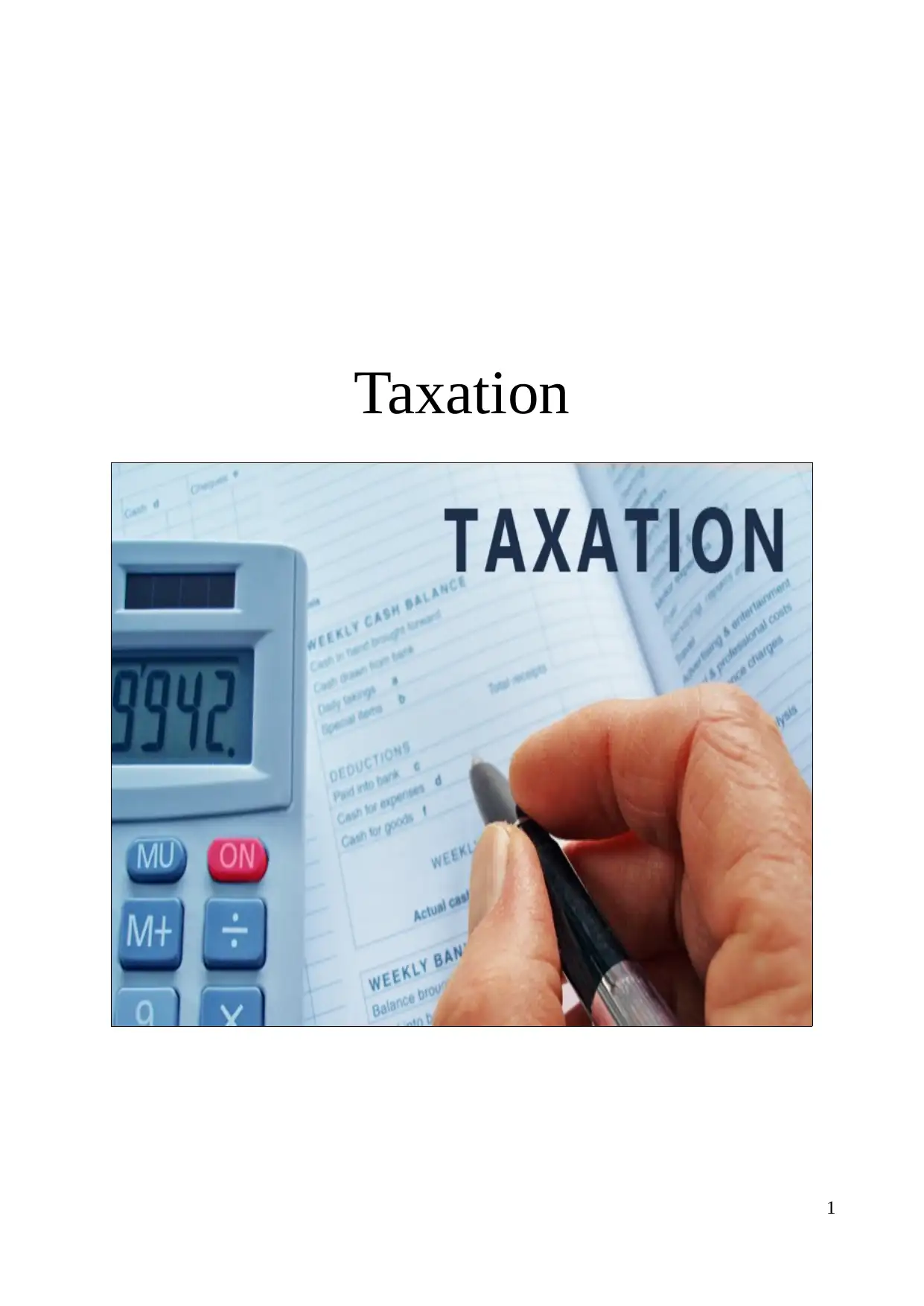
Taxation
1
1
Secure Best Marks with AI Grader
Need help grading? Try our AI Grader for instant feedback on your assignments.

Table of Contents
INTRODUCTION................................................................................................................................4
TASK 1.................................................................................................................................................4
1.1....................................................................................................................................................4
1.2....................................................................................................................................................6
1.3....................................................................................................................................................7
TASK 2.................................................................................................................................................8
2.1....................................................................................................................................................8
2.2 ...................................................................................................................................................9
2.3..................................................................................................................................................10
TASK 3...............................................................................................................................................11
3.1..................................................................................................................................................11
3.2..................................................................................................................................................12
3.3..................................................................................................................................................12
4.1..................................................................................................................................................13
4.2..................................................................................................................................................13
4.3..................................................................................................................................................13
CONCLUSION..................................................................................................................................14
REFERENCES...................................................................................................................................16
2
INTRODUCTION................................................................................................................................4
TASK 1.................................................................................................................................................4
1.1....................................................................................................................................................4
1.2....................................................................................................................................................6
1.3....................................................................................................................................................7
TASK 2.................................................................................................................................................8
2.1....................................................................................................................................................8
2.2 ...................................................................................................................................................9
2.3..................................................................................................................................................10
TASK 3...............................................................................................................................................11
3.1..................................................................................................................................................11
3.2..................................................................................................................................................12
3.3..................................................................................................................................................12
4.1..................................................................................................................................................13
4.2..................................................................................................................................................13
4.3..................................................................................................................................................13
CONCLUSION..................................................................................................................................14
REFERENCES...................................................................................................................................16
2
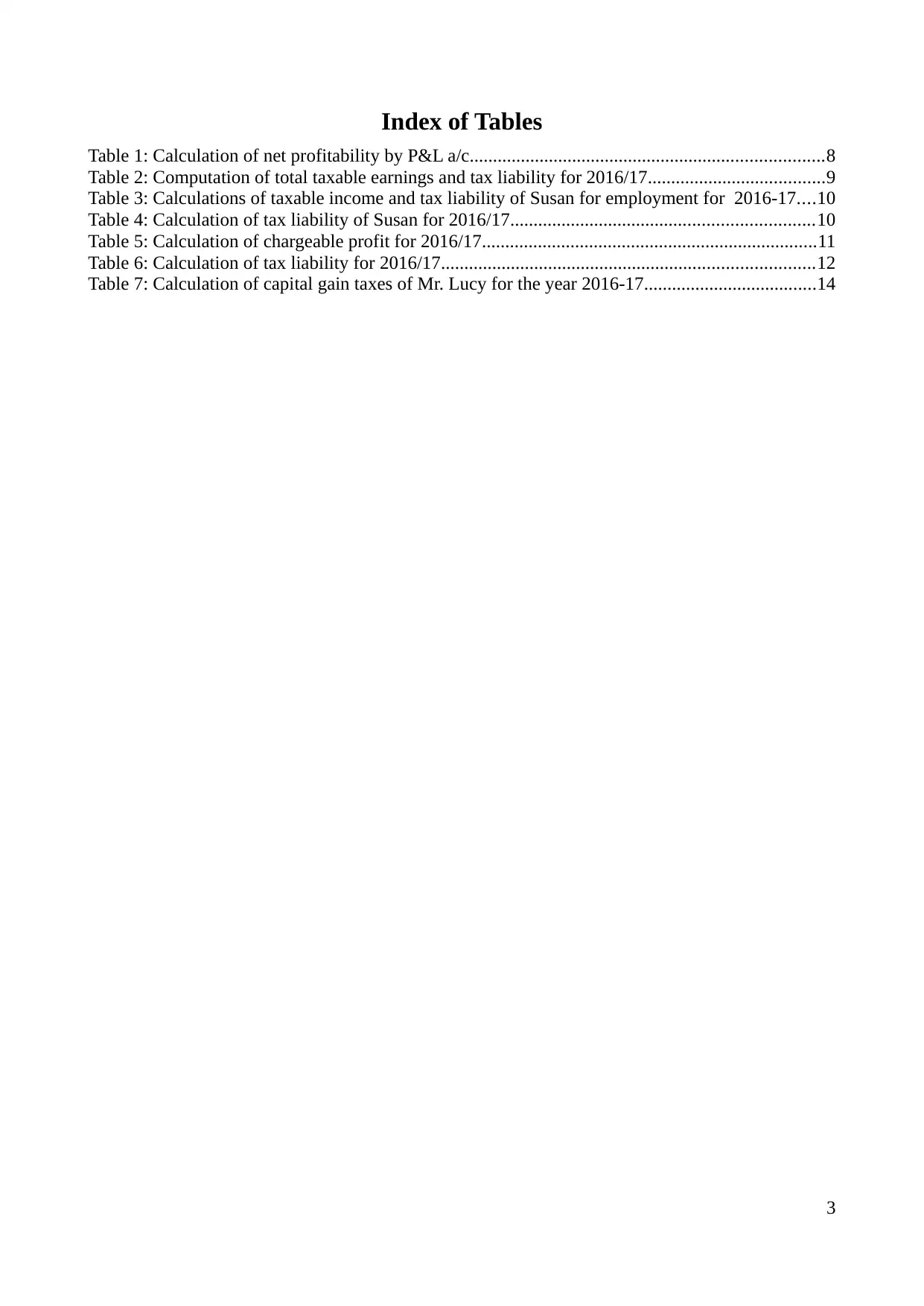
Index of Tables
Table 1: Calculation of net profitability by P&L a/c............................................................................8
Table 2: Computation of total taxable earnings and tax liability for 2016/17......................................9
Table 3: Calculations of taxable income and tax liability of Susan for employment for 2016-17....10
Table 4: Calculation of tax liability of Susan for 2016/17.................................................................10
Table 5: Calculation of chargeable profit for 2016/17........................................................................11
Table 6: Calculation of tax liability for 2016/17................................................................................12
Table 7: Calculation of capital gain taxes of Mr. Lucy for the year 2016-17.....................................14
3
Table 1: Calculation of net profitability by P&L a/c............................................................................8
Table 2: Computation of total taxable earnings and tax liability for 2016/17......................................9
Table 3: Calculations of taxable income and tax liability of Susan for employment for 2016-17....10
Table 4: Calculation of tax liability of Susan for 2016/17.................................................................10
Table 5: Calculation of chargeable profit for 2016/17........................................................................11
Table 6: Calculation of tax liability for 2016/17................................................................................12
Table 7: Calculation of capital gain taxes of Mr. Lucy for the year 2016-17.....................................14
3
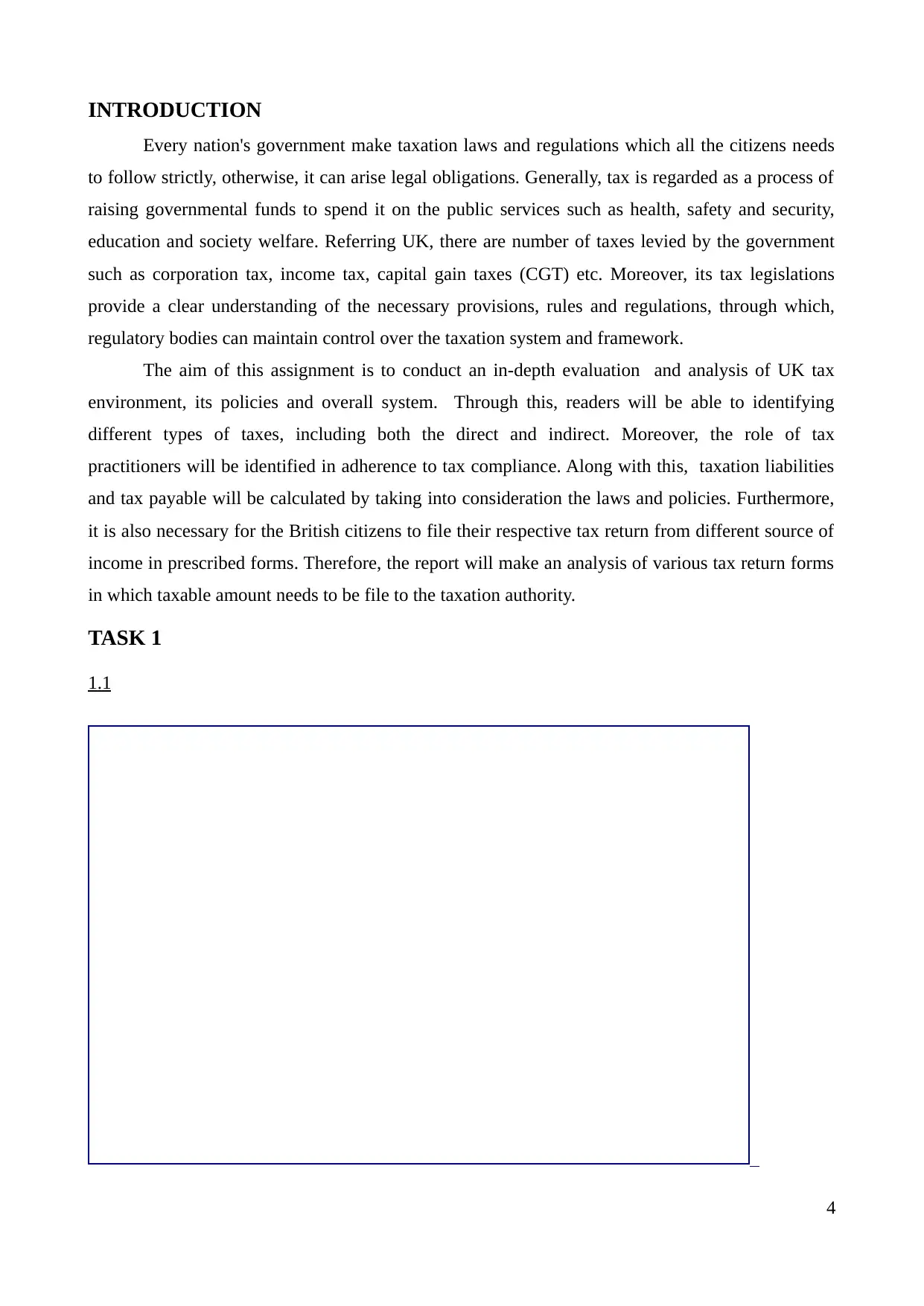
INTRODUCTION
Every nation's government make taxation laws and regulations which all the citizens needs
to follow strictly, otherwise, it can arise legal obligations. Generally, tax is regarded as a process of
raising governmental funds to spend it on the public services such as health, safety and security,
education and society welfare. Referring UK, there are number of taxes levied by the government
such as corporation tax, income tax, capital gain taxes (CGT) etc. Moreover, its tax legislations
provide a clear understanding of the necessary provisions, rules and regulations, through which,
regulatory bodies can maintain control over the taxation system and framework.
The aim of this assignment is to conduct an in-depth evaluation and analysis of UK tax
environment, its policies and overall system. Through this, readers will be able to identifying
different types of taxes, including both the direct and indirect. Moreover, the role of tax
practitioners will be identified in adherence to tax compliance. Along with this, taxation liabilities
and tax payable will be calculated by taking into consideration the laws and policies. Furthermore,
it is also necessary for the British citizens to file their respective tax return from different source of
income in prescribed forms. Therefore, the report will make an analysis of various tax return forms
in which taxable amount needs to be file to the taxation authority.
TASK 1
1.1
4
Every nation's government make taxation laws and regulations which all the citizens needs
to follow strictly, otherwise, it can arise legal obligations. Generally, tax is regarded as a process of
raising governmental funds to spend it on the public services such as health, safety and security,
education and society welfare. Referring UK, there are number of taxes levied by the government
such as corporation tax, income tax, capital gain taxes (CGT) etc. Moreover, its tax legislations
provide a clear understanding of the necessary provisions, rules and regulations, through which,
regulatory bodies can maintain control over the taxation system and framework.
The aim of this assignment is to conduct an in-depth evaluation and analysis of UK tax
environment, its policies and overall system. Through this, readers will be able to identifying
different types of taxes, including both the direct and indirect. Moreover, the role of tax
practitioners will be identified in adherence to tax compliance. Along with this, taxation liabilities
and tax payable will be calculated by taking into consideration the laws and policies. Furthermore,
it is also necessary for the British citizens to file their respective tax return from different source of
income in prescribed forms. Therefore, the report will make an analysis of various tax return forms
in which taxable amount needs to be file to the taxation authority.
TASK 1
1.1
4
Secure Best Marks with AI Grader
Need help grading? Try our AI Grader for instant feedback on your assignments.
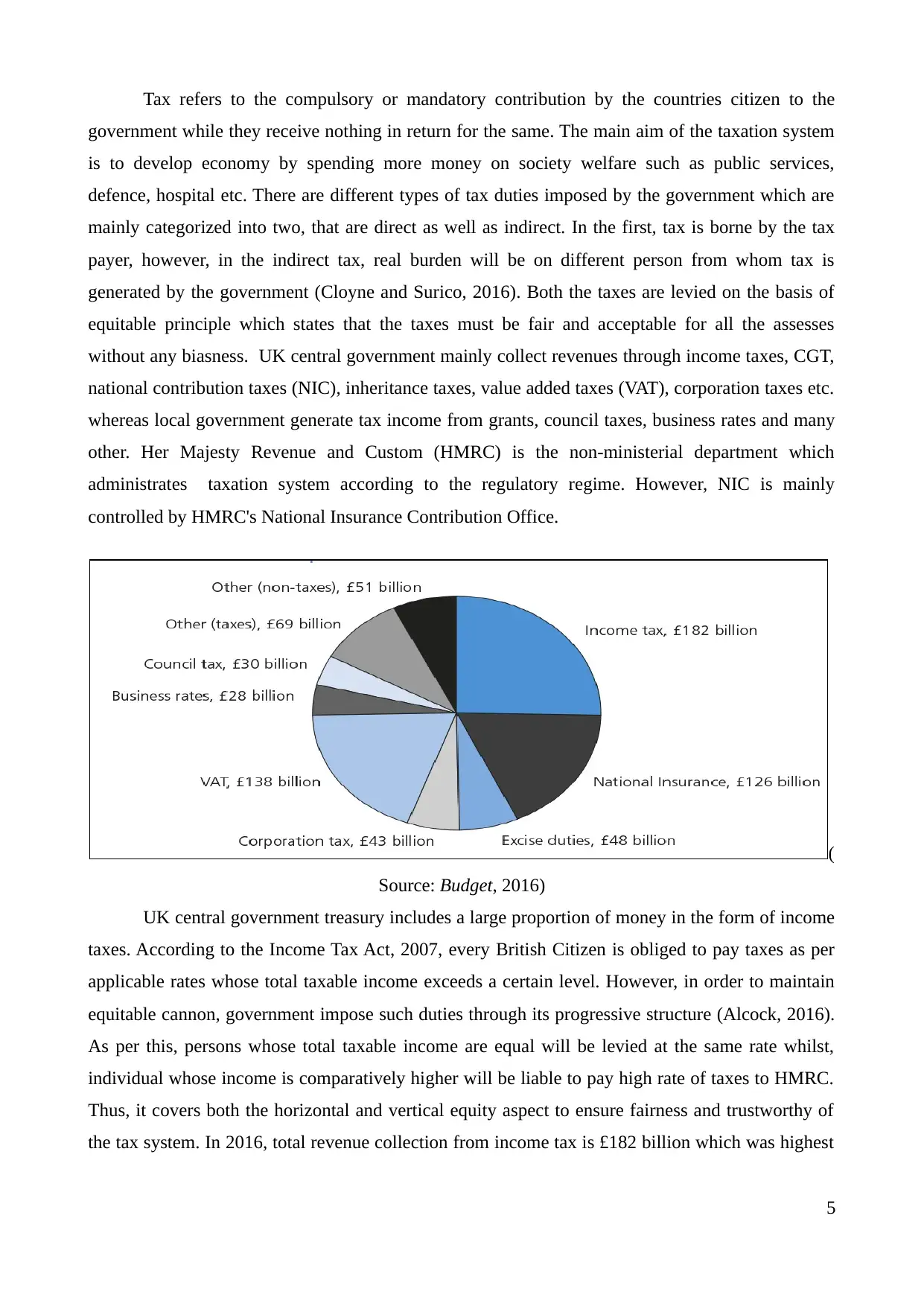
Tax refers to the compulsory or mandatory contribution by the countries citizen to the
government while they receive nothing in return for the same. The main aim of the taxation system
is to develop economy by spending more money on society welfare such as public services,
defence, hospital etc. There are different types of tax duties imposed by the government which are
mainly categorized into two, that are direct as well as indirect. In the first, tax is borne by the tax
payer, however, in the indirect tax, real burden will be on different person from whom tax is
generated by the government (Cloyne and Surico, 2016). Both the taxes are levied on the basis of
equitable principle which states that the taxes must be fair and acceptable for all the assesses
without any biasness. UK central government mainly collect revenues through income taxes, CGT,
national contribution taxes (NIC), inheritance taxes, value added taxes (VAT), corporation taxes etc.
whereas local government generate tax income from grants, council taxes, business rates and many
other. Her Majesty Revenue and Custom (HMRC) is the non-ministerial department which
administrates taxation system according to the regulatory regime. However, NIC is mainly
controlled by HMRC's National Insurance Contribution Office.
(
Source: Budget, 2016)
UK central government treasury includes a large proportion of money in the form of income
taxes. According to the Income Tax Act, 2007, every British Citizen is obliged to pay taxes as per
applicable rates whose total taxable income exceeds a certain level. However, in order to maintain
equitable cannon, government impose such duties through its progressive structure (Alcock, 2016).
As per this, persons whose total taxable income are equal will be levied at the same rate whilst,
individual whose income is comparatively higher will be liable to pay high rate of taxes to HMRC.
Thus, it covers both the horizontal and vertical equity aspect to ensure fairness and trustworthy of
the tax system. In 2016, total revenue collection from income tax is £182 billion which was highest
5
government while they receive nothing in return for the same. The main aim of the taxation system
is to develop economy by spending more money on society welfare such as public services,
defence, hospital etc. There are different types of tax duties imposed by the government which are
mainly categorized into two, that are direct as well as indirect. In the first, tax is borne by the tax
payer, however, in the indirect tax, real burden will be on different person from whom tax is
generated by the government (Cloyne and Surico, 2016). Both the taxes are levied on the basis of
equitable principle which states that the taxes must be fair and acceptable for all the assesses
without any biasness. UK central government mainly collect revenues through income taxes, CGT,
national contribution taxes (NIC), inheritance taxes, value added taxes (VAT), corporation taxes etc.
whereas local government generate tax income from grants, council taxes, business rates and many
other. Her Majesty Revenue and Custom (HMRC) is the non-ministerial department which
administrates taxation system according to the regulatory regime. However, NIC is mainly
controlled by HMRC's National Insurance Contribution Office.
(
Source: Budget, 2016)
UK central government treasury includes a large proportion of money in the form of income
taxes. According to the Income Tax Act, 2007, every British Citizen is obliged to pay taxes as per
applicable rates whose total taxable income exceeds a certain level. However, in order to maintain
equitable cannon, government impose such duties through its progressive structure (Alcock, 2016).
As per this, persons whose total taxable income are equal will be levied at the same rate whilst,
individual whose income is comparatively higher will be liable to pay high rate of taxes to HMRC.
Thus, it covers both the horizontal and vertical equity aspect to ensure fairness and trustworthy of
the tax system. In 2016, total revenue collection from income tax is £182 billion which was highest
5
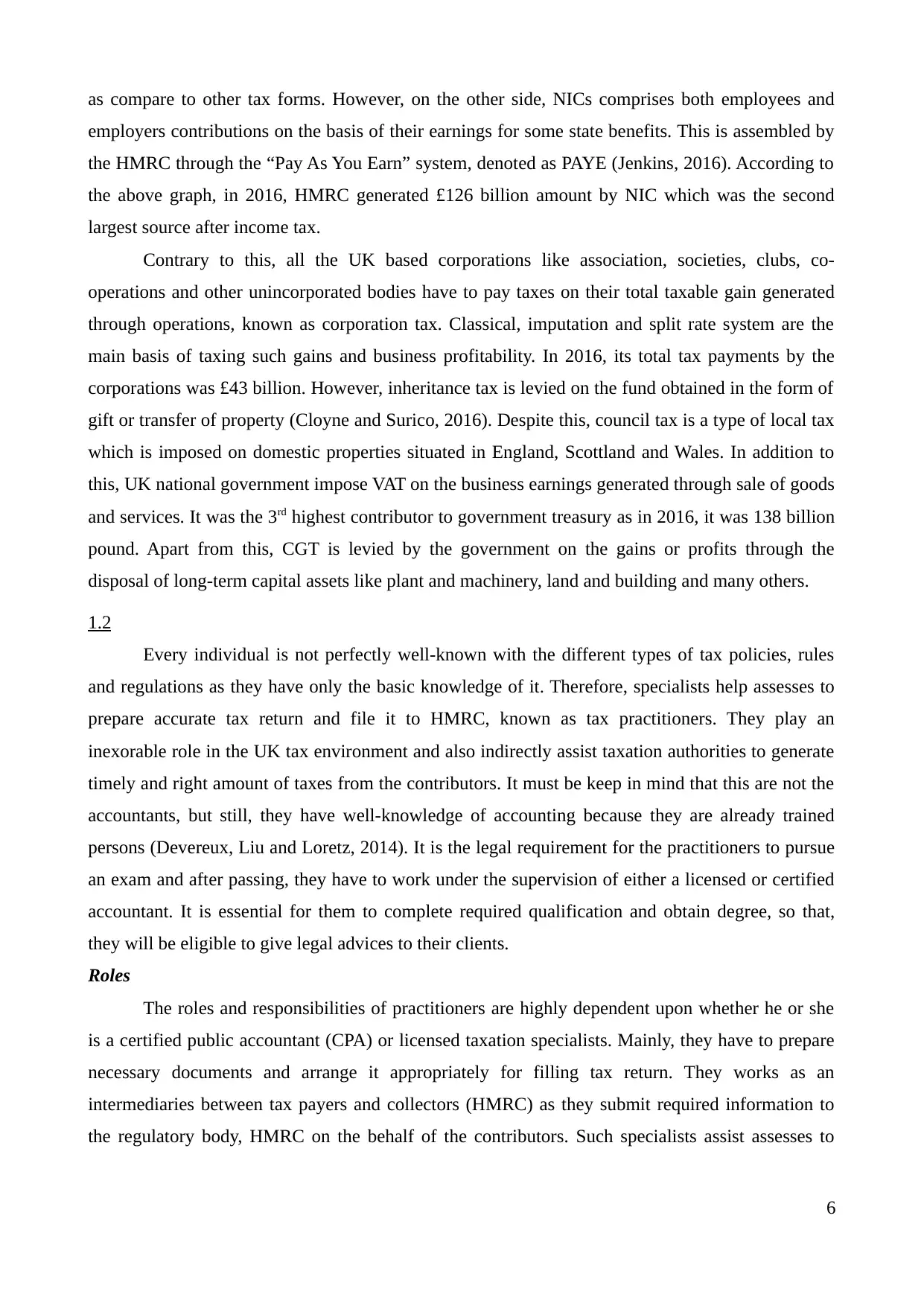
as compare to other tax forms. However, on the other side, NICs comprises both employees and
employers contributions on the basis of their earnings for some state benefits. This is assembled by
the HMRC through the “Pay As You Earn” system, denoted as PAYE (Jenkins, 2016). According to
the above graph, in 2016, HMRC generated £126 billion amount by NIC which was the second
largest source after income tax.
Contrary to this, all the UK based corporations like association, societies, clubs, co-
operations and other unincorporated bodies have to pay taxes on their total taxable gain generated
through operations, known as corporation tax. Classical, imputation and split rate system are the
main basis of taxing such gains and business profitability. In 2016, its total tax payments by the
corporations was £43 billion. However, inheritance tax is levied on the fund obtained in the form of
gift or transfer of property (Cloyne and Surico, 2016). Despite this, council tax is a type of local tax
which is imposed on domestic properties situated in England, Scottland and Wales. In addition to
this, UK national government impose VAT on the business earnings generated through sale of goods
and services. It was the 3rd highest contributor to government treasury as in 2016, it was 138 billion
pound. Apart from this, CGT is levied by the government on the gains or profits through the
disposal of long-term capital assets like plant and machinery, land and building and many others.
1.2
Every individual is not perfectly well-known with the different types of tax policies, rules
and regulations as they have only the basic knowledge of it. Therefore, specialists help assesses to
prepare accurate tax return and file it to HMRC, known as tax practitioners. They play an
inexorable role in the UK tax environment and also indirectly assist taxation authorities to generate
timely and right amount of taxes from the contributors. It must be keep in mind that this are not the
accountants, but still, they have well-knowledge of accounting because they are already trained
persons (Devereux, Liu and Loretz, 2014). It is the legal requirement for the practitioners to pursue
an exam and after passing, they have to work under the supervision of either a licensed or certified
accountant. It is essential for them to complete required qualification and obtain degree, so that,
they will be eligible to give legal advices to their clients.
Roles
The roles and responsibilities of practitioners are highly dependent upon whether he or she
is a certified public accountant (CPA) or licensed taxation specialists. Mainly, they have to prepare
necessary documents and arrange it appropriately for filling tax return. They works as an
intermediaries between tax payers and collectors (HMRC) as they submit required information to
the regulatory body, HMRC on the behalf of the contributors. Such specialists assist assesses to
6
employers contributions on the basis of their earnings for some state benefits. This is assembled by
the HMRC through the “Pay As You Earn” system, denoted as PAYE (Jenkins, 2016). According to
the above graph, in 2016, HMRC generated £126 billion amount by NIC which was the second
largest source after income tax.
Contrary to this, all the UK based corporations like association, societies, clubs, co-
operations and other unincorporated bodies have to pay taxes on their total taxable gain generated
through operations, known as corporation tax. Classical, imputation and split rate system are the
main basis of taxing such gains and business profitability. In 2016, its total tax payments by the
corporations was £43 billion. However, inheritance tax is levied on the fund obtained in the form of
gift or transfer of property (Cloyne and Surico, 2016). Despite this, council tax is a type of local tax
which is imposed on domestic properties situated in England, Scottland and Wales. In addition to
this, UK national government impose VAT on the business earnings generated through sale of goods
and services. It was the 3rd highest contributor to government treasury as in 2016, it was 138 billion
pound. Apart from this, CGT is levied by the government on the gains or profits through the
disposal of long-term capital assets like plant and machinery, land and building and many others.
1.2
Every individual is not perfectly well-known with the different types of tax policies, rules
and regulations as they have only the basic knowledge of it. Therefore, specialists help assesses to
prepare accurate tax return and file it to HMRC, known as tax practitioners. They play an
inexorable role in the UK tax environment and also indirectly assist taxation authorities to generate
timely and right amount of taxes from the contributors. It must be keep in mind that this are not the
accountants, but still, they have well-knowledge of accounting because they are already trained
persons (Devereux, Liu and Loretz, 2014). It is the legal requirement for the practitioners to pursue
an exam and after passing, they have to work under the supervision of either a licensed or certified
accountant. It is essential for them to complete required qualification and obtain degree, so that,
they will be eligible to give legal advices to their clients.
Roles
The roles and responsibilities of practitioners are highly dependent upon whether he or she
is a certified public accountant (CPA) or licensed taxation specialists. Mainly, they have to prepare
necessary documents and arrange it appropriately for filling tax return. They works as an
intermediaries between tax payers and collectors (HMRC) as they submit required information to
the regulatory body, HMRC on the behalf of the contributors. Such specialists assist assesses to
6
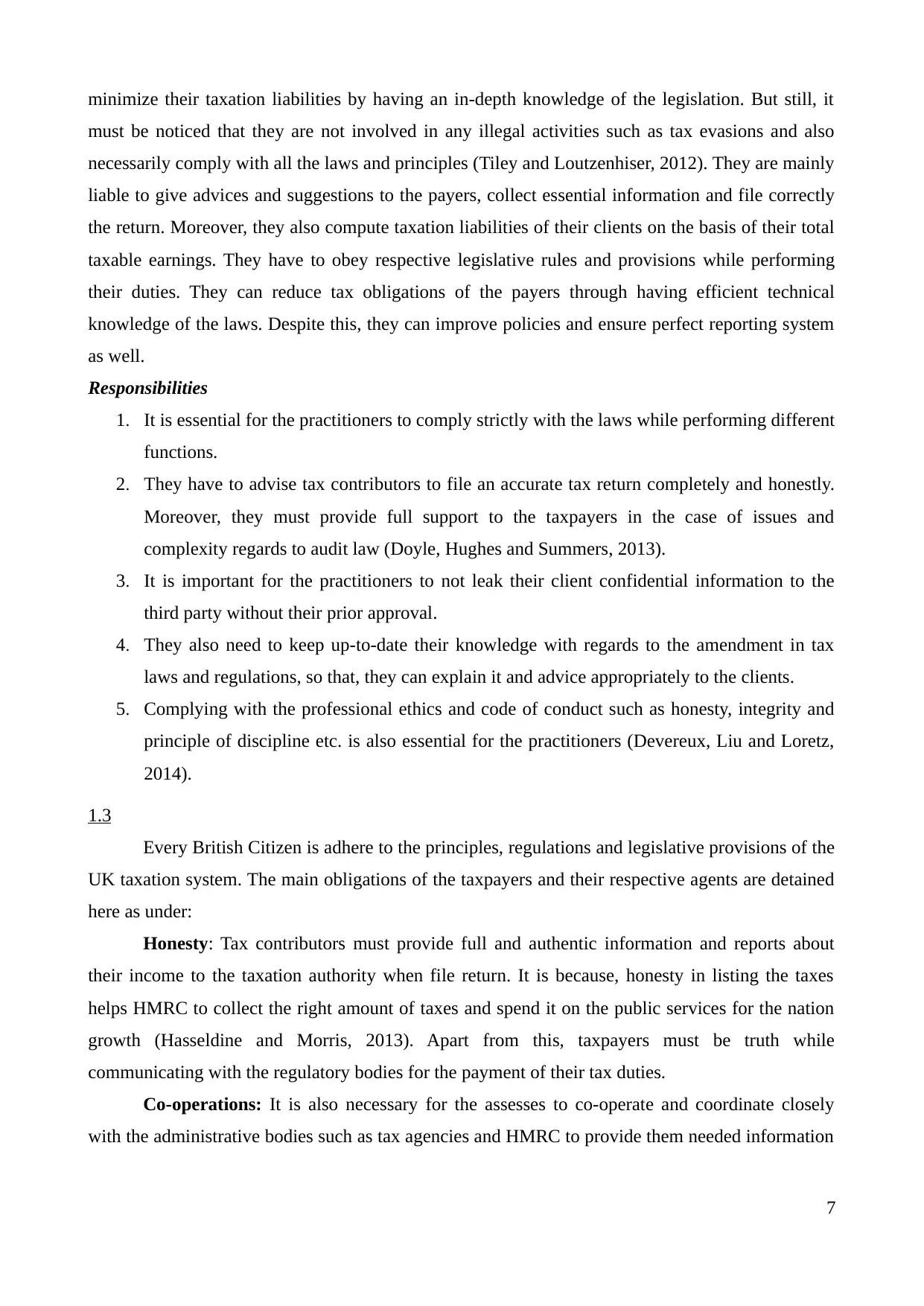
minimize their taxation liabilities by having an in-depth knowledge of the legislation. But still, it
must be noticed that they are not involved in any illegal activities such as tax evasions and also
necessarily comply with all the laws and principles (Tiley and Loutzenhiser, 2012). They are mainly
liable to give advices and suggestions to the payers, collect essential information and file correctly
the return. Moreover, they also compute taxation liabilities of their clients on the basis of their total
taxable earnings. They have to obey respective legislative rules and provisions while performing
their duties. They can reduce tax obligations of the payers through having efficient technical
knowledge of the laws. Despite this, they can improve policies and ensure perfect reporting system
as well.
Responsibilities
1. It is essential for the practitioners to comply strictly with the laws while performing different
functions.
2. They have to advise tax contributors to file an accurate tax return completely and honestly.
Moreover, they must provide full support to the taxpayers in the case of issues and
complexity regards to audit law (Doyle, Hughes and Summers, 2013).
3. It is important for the practitioners to not leak their client confidential information to the
third party without their prior approval.
4. They also need to keep up-to-date their knowledge with regards to the amendment in tax
laws and regulations, so that, they can explain it and advice appropriately to the clients.
5. Complying with the professional ethics and code of conduct such as honesty, integrity and
principle of discipline etc. is also essential for the practitioners (Devereux, Liu and Loretz,
2014).
1.3
Every British Citizen is adhere to the principles, regulations and legislative provisions of the
UK taxation system. The main obligations of the taxpayers and their respective agents are detained
here as under:
Honesty: Tax contributors must provide full and authentic information and reports about
their income to the taxation authority when file return. It is because, honesty in listing the taxes
helps HMRC to collect the right amount of taxes and spend it on the public services for the nation
growth (Hasseldine and Morris, 2013). Apart from this, taxpayers must be truth while
communicating with the regulatory bodies for the payment of their tax duties.
Co-operations: It is also necessary for the assesses to co-operate and coordinate closely
with the administrative bodies such as tax agencies and HMRC to provide them needed information
7
must be noticed that they are not involved in any illegal activities such as tax evasions and also
necessarily comply with all the laws and principles (Tiley and Loutzenhiser, 2012). They are mainly
liable to give advices and suggestions to the payers, collect essential information and file correctly
the return. Moreover, they also compute taxation liabilities of their clients on the basis of their total
taxable earnings. They have to obey respective legislative rules and provisions while performing
their duties. They can reduce tax obligations of the payers through having efficient technical
knowledge of the laws. Despite this, they can improve policies and ensure perfect reporting system
as well.
Responsibilities
1. It is essential for the practitioners to comply strictly with the laws while performing different
functions.
2. They have to advise tax contributors to file an accurate tax return completely and honestly.
Moreover, they must provide full support to the taxpayers in the case of issues and
complexity regards to audit law (Doyle, Hughes and Summers, 2013).
3. It is important for the practitioners to not leak their client confidential information to the
third party without their prior approval.
4. They also need to keep up-to-date their knowledge with regards to the amendment in tax
laws and regulations, so that, they can explain it and advice appropriately to the clients.
5. Complying with the professional ethics and code of conduct such as honesty, integrity and
principle of discipline etc. is also essential for the practitioners (Devereux, Liu and Loretz,
2014).
1.3
Every British Citizen is adhere to the principles, regulations and legislative provisions of the
UK taxation system. The main obligations of the taxpayers and their respective agents are detained
here as under:
Honesty: Tax contributors must provide full and authentic information and reports about
their income to the taxation authority when file return. It is because, honesty in listing the taxes
helps HMRC to collect the right amount of taxes and spend it on the public services for the nation
growth (Hasseldine and Morris, 2013). Apart from this, taxpayers must be truth while
communicating with the regulatory bodies for the payment of their tax duties.
Co-operations: It is also necessary for the assesses to co-operate and coordinate closely
with the administrative bodies such as tax agencies and HMRC to provide them needed information
7
Paraphrase This Document
Need a fresh take? Get an instant paraphrase of this document with our AI Paraphraser
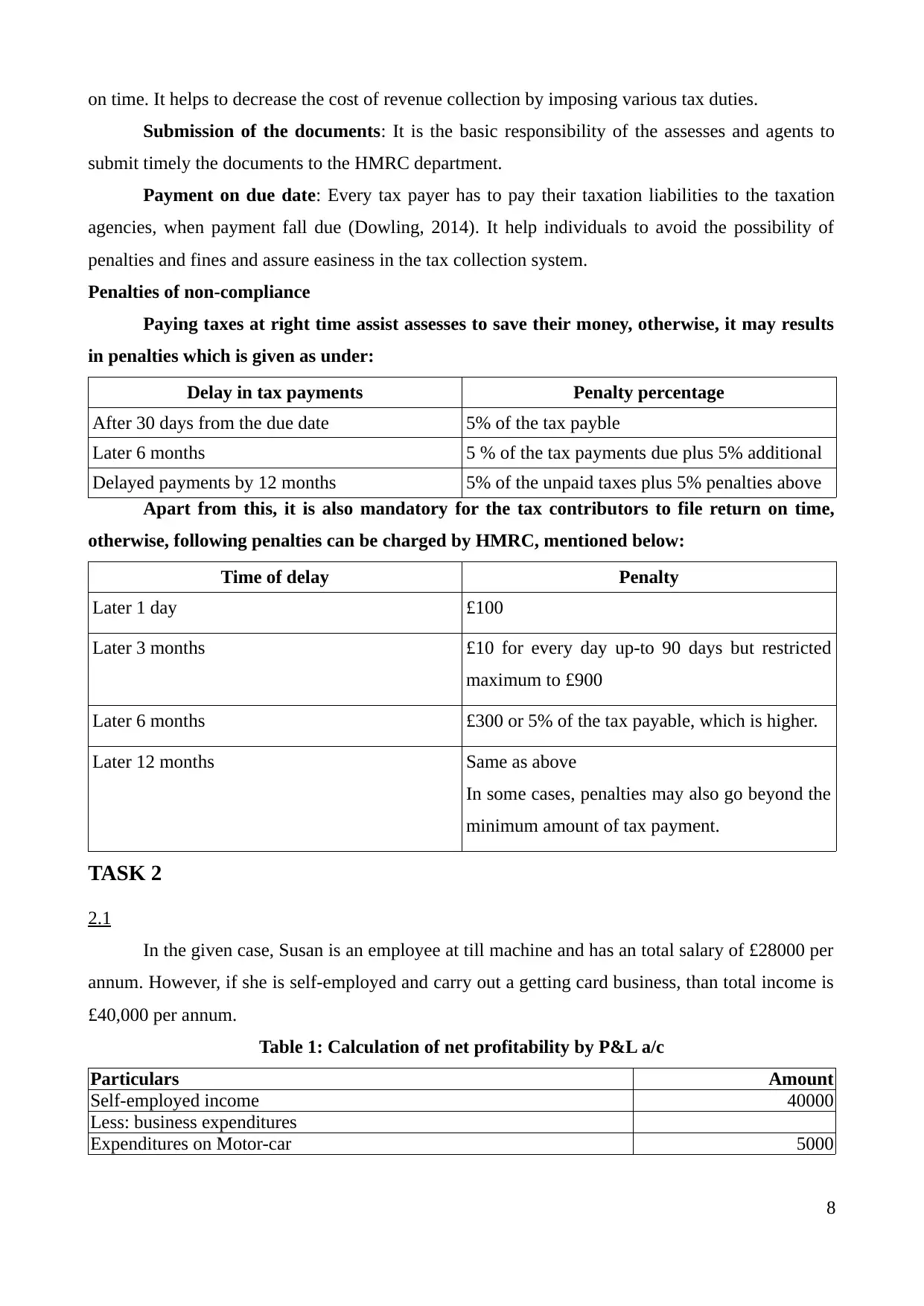
on time. It helps to decrease the cost of revenue collection by imposing various tax duties.
Submission of the documents: It is the basic responsibility of the assesses and agents to
submit timely the documents to the HMRC department.
Payment on due date: Every tax payer has to pay their taxation liabilities to the taxation
agencies, when payment fall due (Dowling, 2014). It help individuals to avoid the possibility of
penalties and fines and assure easiness in the tax collection system.
Penalties of non-compliance
Paying taxes at right time assist assesses to save their money, otherwise, it may results
in penalties which is given as under:
Delay in tax payments Penalty percentage
After 30 days from the due date 5% of the tax payble
Later 6 months 5 % of the tax payments due plus 5% additional
Delayed payments by 12 months 5% of the unpaid taxes plus 5% penalties above
Apart from this, it is also mandatory for the tax contributors to file return on time,
otherwise, following penalties can be charged by HMRC, mentioned below:
Time of delay Penalty
Later 1 day £100
Later 3 months £10 for every day up-to 90 days but restricted
maximum to £900
Later 6 months £300 or 5% of the tax payable, which is higher.
Later 12 months Same as above
In some cases, penalties may also go beyond the
minimum amount of tax payment.
TASK 2
2.1
In the given case, Susan is an employee at till machine and has an total salary of £28000 per
annum. However, if she is self-employed and carry out a getting card business, than total income is
£40,000 per annum.
Table 1: Calculation of net profitability by P&L a/c
Particulars Amount
Self-employed income 40000
Less: business expenditures
Expenditures on Motor-car 5000
8
Submission of the documents: It is the basic responsibility of the assesses and agents to
submit timely the documents to the HMRC department.
Payment on due date: Every tax payer has to pay their taxation liabilities to the taxation
agencies, when payment fall due (Dowling, 2014). It help individuals to avoid the possibility of
penalties and fines and assure easiness in the tax collection system.
Penalties of non-compliance
Paying taxes at right time assist assesses to save their money, otherwise, it may results
in penalties which is given as under:
Delay in tax payments Penalty percentage
After 30 days from the due date 5% of the tax payble
Later 6 months 5 % of the tax payments due plus 5% additional
Delayed payments by 12 months 5% of the unpaid taxes plus 5% penalties above
Apart from this, it is also mandatory for the tax contributors to file return on time,
otherwise, following penalties can be charged by HMRC, mentioned below:
Time of delay Penalty
Later 1 day £100
Later 3 months £10 for every day up-to 90 days but restricted
maximum to £900
Later 6 months £300 or 5% of the tax payable, which is higher.
Later 12 months Same as above
In some cases, penalties may also go beyond the
minimum amount of tax payment.
TASK 2
2.1
In the given case, Susan is an employee at till machine and has an total salary of £28000 per
annum. However, if she is self-employed and carry out a getting card business, than total income is
£40,000 per annum.
Table 1: Calculation of net profitability by P&L a/c
Particulars Amount
Self-employed income 40000
Less: business expenditures
Expenditures on Motor-car 5000
8
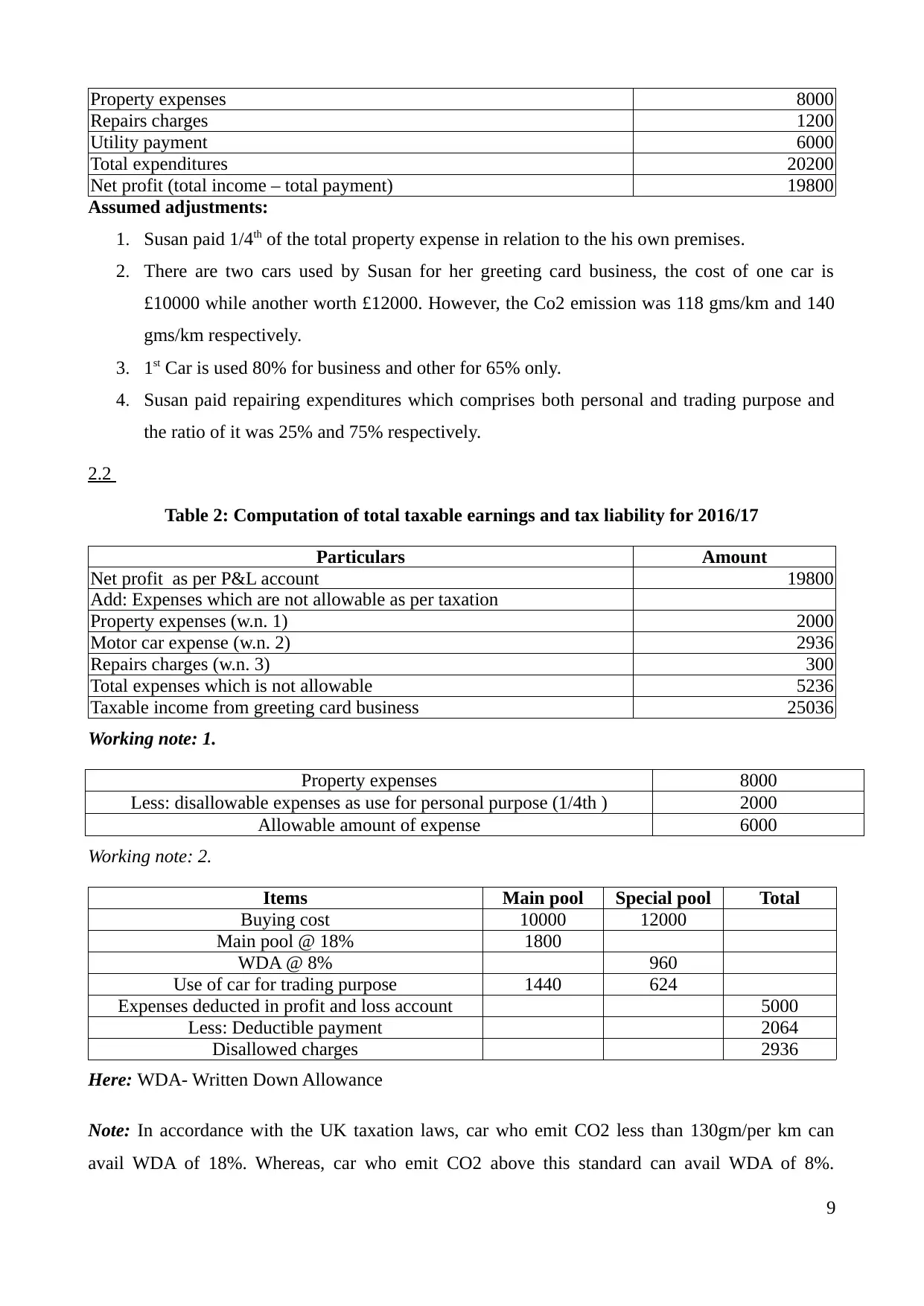
Property expenses 8000
Repairs charges 1200
Utility payment 6000
Total expenditures 20200
Net profit (total income – total payment) 19800
Assumed adjustments:
1. Susan paid 1/4th of the total property expense in relation to the his own premises.
2. There are two cars used by Susan for her greeting card business, the cost of one car is
£10000 while another worth £12000. However, the Co2 emission was 118 gms/km and 140
gms/km respectively.
3. 1st Car is used 80% for business and other for 65% only.
4. Susan paid repairing expenditures which comprises both personal and trading purpose and
the ratio of it was 25% and 75% respectively.
2.2
Table 2: Computation of total taxable earnings and tax liability for 2016/17
Particulars Amount
Net profit as per P&L account 19800
Add: Expenses which are not allowable as per taxation
Property expenses (w.n. 1) 2000
Motor car expense (w.n. 2) 2936
Repairs charges (w.n. 3) 300
Total expenses which is not allowable 5236
Taxable income from greeting card business 25036
Working note: 1.
Property expenses 8000
Less: disallowable expenses as use for personal purpose (1/4th ) 2000
Allowable amount of expense 6000
Working note: 2.
Items Main pool Special pool Total
Buying cost 10000 12000
Main pool @ 18% 1800
WDA @ 8% 960
Use of car for trading purpose 1440 624
Expenses deducted in profit and loss account 5000
Less: Deductible payment 2064
Disallowed charges 2936
Here: WDA- Written Down Allowance
Note: In accordance with the UK taxation laws, car who emit CO2 less than 130gm/per km can
avail WDA of 18%. Whereas, car who emit CO2 above this standard can avail WDA of 8%.
9
Repairs charges 1200
Utility payment 6000
Total expenditures 20200
Net profit (total income – total payment) 19800
Assumed adjustments:
1. Susan paid 1/4th of the total property expense in relation to the his own premises.
2. There are two cars used by Susan for her greeting card business, the cost of one car is
£10000 while another worth £12000. However, the Co2 emission was 118 gms/km and 140
gms/km respectively.
3. 1st Car is used 80% for business and other for 65% only.
4. Susan paid repairing expenditures which comprises both personal and trading purpose and
the ratio of it was 25% and 75% respectively.
2.2
Table 2: Computation of total taxable earnings and tax liability for 2016/17
Particulars Amount
Net profit as per P&L account 19800
Add: Expenses which are not allowable as per taxation
Property expenses (w.n. 1) 2000
Motor car expense (w.n. 2) 2936
Repairs charges (w.n. 3) 300
Total expenses which is not allowable 5236
Taxable income from greeting card business 25036
Working note: 1.
Property expenses 8000
Less: disallowable expenses as use for personal purpose (1/4th ) 2000
Allowable amount of expense 6000
Working note: 2.
Items Main pool Special pool Total
Buying cost 10000 12000
Main pool @ 18% 1800
WDA @ 8% 960
Use of car for trading purpose 1440 624
Expenses deducted in profit and loss account 5000
Less: Deductible payment 2064
Disallowed charges 2936
Here: WDA- Written Down Allowance
Note: In accordance with the UK taxation laws, car who emit CO2 less than 130gm/per km can
avail WDA of 18%. Whereas, car who emit CO2 above this standard can avail WDA of 8%.
9
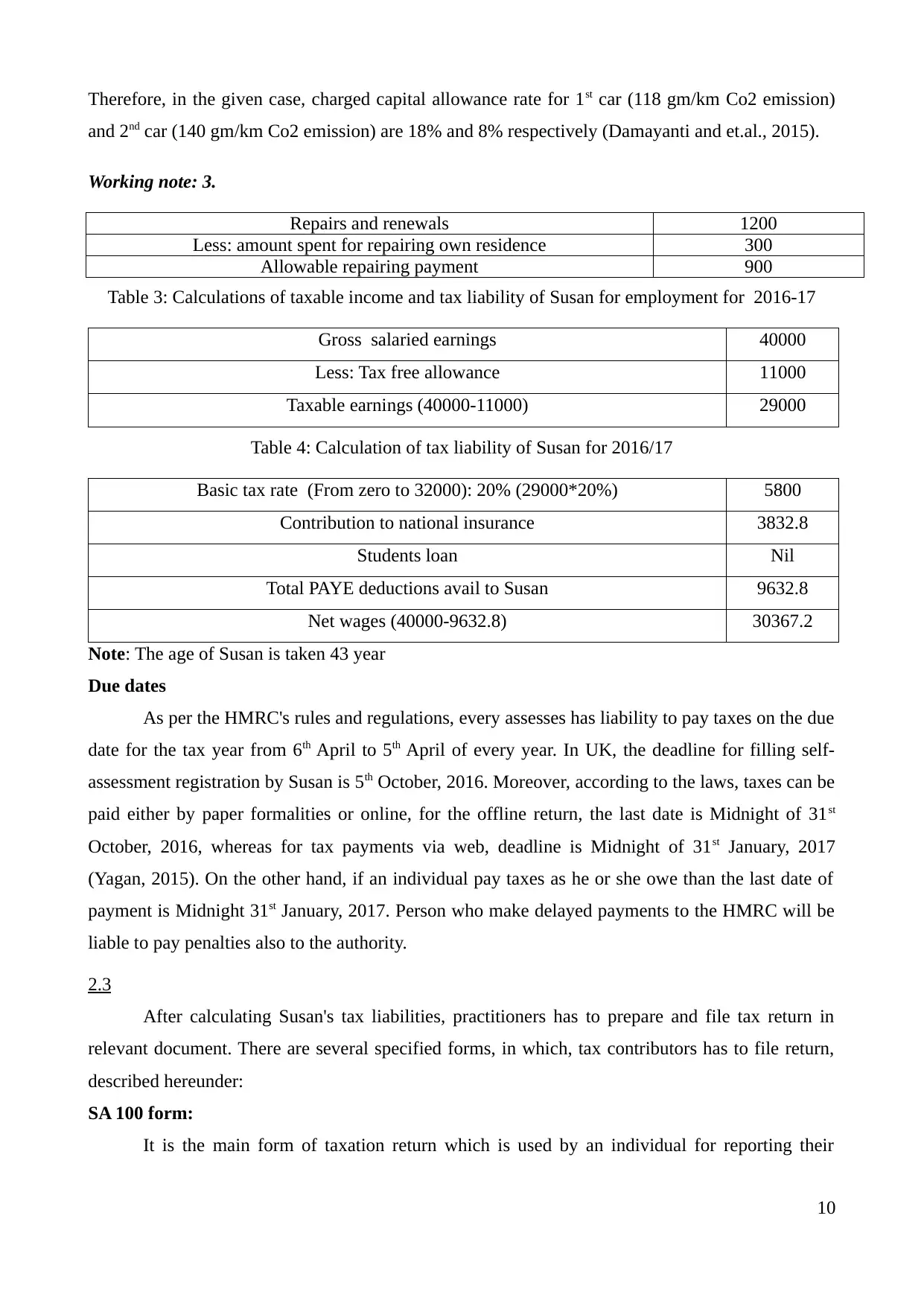
Therefore, in the given case, charged capital allowance rate for 1st car (118 gm/km Co2 emission)
and 2nd car (140 gm/km Co2 emission) are 18% and 8% respectively (Damayanti and et.al., 2015).
Working note: 3.
Repairs and renewals 1200
Less: amount spent for repairing own residence 300
Allowable repairing payment 900
Table 3: Calculations of taxable income and tax liability of Susan for employment for 2016-17
Gross salaried earnings 40000
Less: Tax free allowance 11000
Taxable earnings (40000-11000) 29000
Table 4: Calculation of tax liability of Susan for 2016/17
Basic tax rate (From zero to 32000): 20% (29000*20%) 5800
Contribution to national insurance 3832.8
Students loan Nil
Total PAYE deductions avail to Susan 9632.8
Net wages (40000-9632.8) 30367.2
Note: The age of Susan is taken 43 year
Due dates
As per the HMRC's rules and regulations, every assesses has liability to pay taxes on the due
date for the tax year from 6th April to 5th April of every year. In UK, the deadline for filling self-
assessment registration by Susan is 5th October, 2016. Moreover, according to the laws, taxes can be
paid either by paper formalities or online, for the offline return, the last date is Midnight of 31st
October, 2016, whereas for tax payments via web, deadline is Midnight of 31st January, 2017
(Yagan, 2015). On the other hand, if an individual pay taxes as he or she owe than the last date of
payment is Midnight 31st January, 2017. Person who make delayed payments to the HMRC will be
liable to pay penalties also to the authority.
2.3
After calculating Susan's tax liabilities, practitioners has to prepare and file tax return in
relevant document. There are several specified forms, in which, tax contributors has to file return,
described hereunder:
SA 100 form:
It is the main form of taxation return which is used by an individual for reporting their
10
and 2nd car (140 gm/km Co2 emission) are 18% and 8% respectively (Damayanti and et.al., 2015).
Working note: 3.
Repairs and renewals 1200
Less: amount spent for repairing own residence 300
Allowable repairing payment 900
Table 3: Calculations of taxable income and tax liability of Susan for employment for 2016-17
Gross salaried earnings 40000
Less: Tax free allowance 11000
Taxable earnings (40000-11000) 29000
Table 4: Calculation of tax liability of Susan for 2016/17
Basic tax rate (From zero to 32000): 20% (29000*20%) 5800
Contribution to national insurance 3832.8
Students loan Nil
Total PAYE deductions avail to Susan 9632.8
Net wages (40000-9632.8) 30367.2
Note: The age of Susan is taken 43 year
Due dates
As per the HMRC's rules and regulations, every assesses has liability to pay taxes on the due
date for the tax year from 6th April to 5th April of every year. In UK, the deadline for filling self-
assessment registration by Susan is 5th October, 2016. Moreover, according to the laws, taxes can be
paid either by paper formalities or online, for the offline return, the last date is Midnight of 31st
October, 2016, whereas for tax payments via web, deadline is Midnight of 31st January, 2017
(Yagan, 2015). On the other hand, if an individual pay taxes as he or she owe than the last date of
payment is Midnight 31st January, 2017. Person who make delayed payments to the HMRC will be
liable to pay penalties also to the authority.
2.3
After calculating Susan's tax liabilities, practitioners has to prepare and file tax return in
relevant document. There are several specified forms, in which, tax contributors has to file return,
described hereunder:
SA 100 form:
It is the main form of taxation return which is used by an individual for reporting their
10
Secure Best Marks with AI Grader
Need help grading? Try our AI Grader for instant feedback on your assignments.
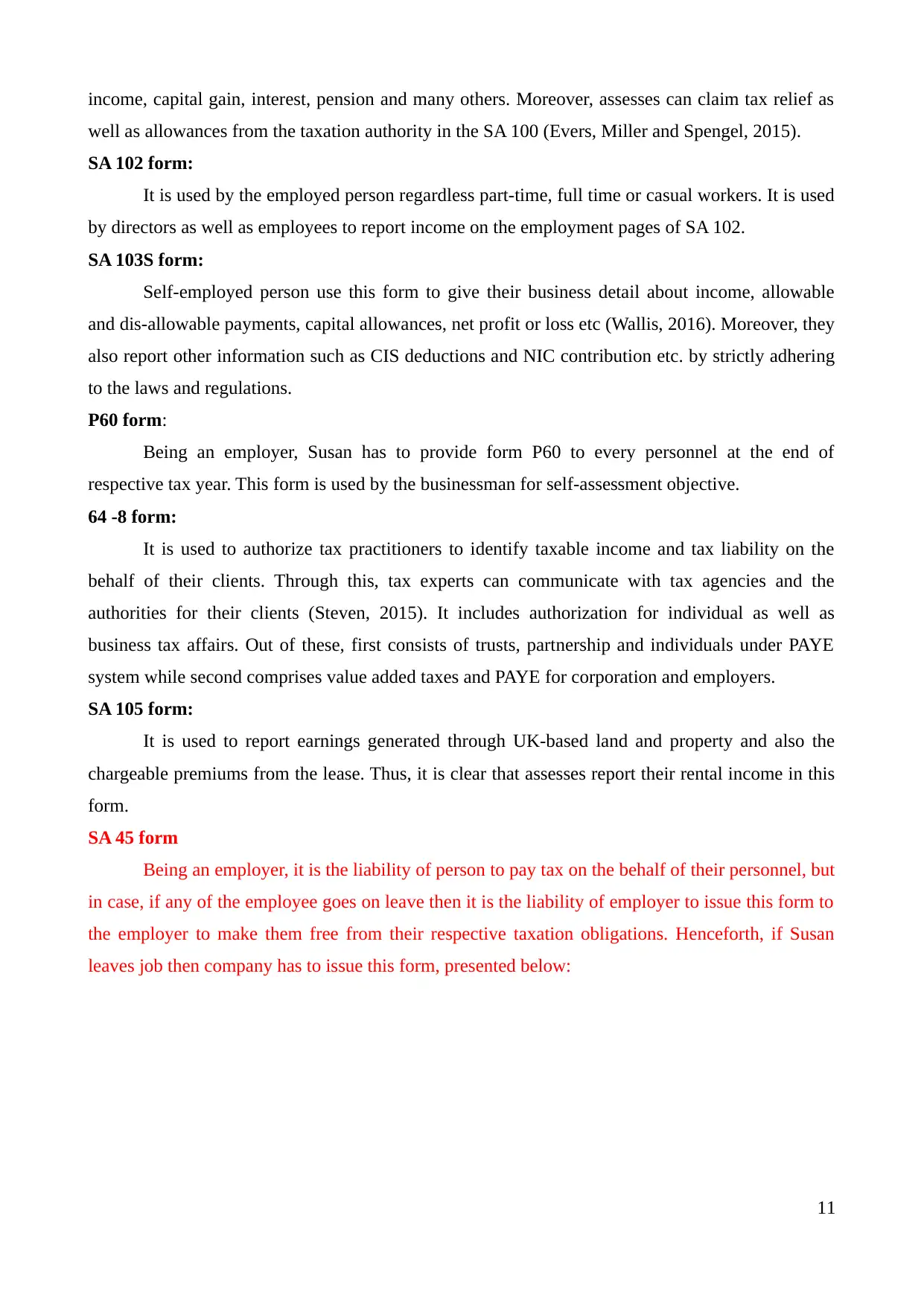
income, capital gain, interest, pension and many others. Moreover, assesses can claim tax relief as
well as allowances from the taxation authority in the SA 100 (Evers, Miller and Spengel, 2015).
SA 102 form:
It is used by the employed person regardless part-time, full time or casual workers. It is used
by directors as well as employees to report income on the employment pages of SA 102.
SA 103S form:
Self-employed person use this form to give their business detail about income, allowable
and dis-allowable payments, capital allowances, net profit or loss etc (Wallis, 2016). Moreover, they
also report other information such as CIS deductions and NIC contribution etc. by strictly adhering
to the laws and regulations.
P60 form:
Being an employer, Susan has to provide form P60 to every personnel at the end of
respective tax year. This form is used by the businessman for self-assessment objective.
64 -8 form:
It is used to authorize tax practitioners to identify taxable income and tax liability on the
behalf of their clients. Through this, tax experts can communicate with tax agencies and the
authorities for their clients (Steven, 2015). It includes authorization for individual as well as
business tax affairs. Out of these, first consists of trusts, partnership and individuals under PAYE
system while second comprises value added taxes and PAYE for corporation and employers.
SA 105 form:
It is used to report earnings generated through UK-based land and property and also the
chargeable premiums from the lease. Thus, it is clear that assesses report their rental income in this
form.
SA 45 form
Being an employer, it is the liability of person to pay tax on the behalf of their personnel, but
in case, if any of the employee goes on leave then it is the liability of employer to issue this form to
the employer to make them free from their respective taxation obligations. Henceforth, if Susan
leaves job then company has to issue this form, presented below:
11
well as allowances from the taxation authority in the SA 100 (Evers, Miller and Spengel, 2015).
SA 102 form:
It is used by the employed person regardless part-time, full time or casual workers. It is used
by directors as well as employees to report income on the employment pages of SA 102.
SA 103S form:
Self-employed person use this form to give their business detail about income, allowable
and dis-allowable payments, capital allowances, net profit or loss etc (Wallis, 2016). Moreover, they
also report other information such as CIS deductions and NIC contribution etc. by strictly adhering
to the laws and regulations.
P60 form:
Being an employer, Susan has to provide form P60 to every personnel at the end of
respective tax year. This form is used by the businessman for self-assessment objective.
64 -8 form:
It is used to authorize tax practitioners to identify taxable income and tax liability on the
behalf of their clients. Through this, tax experts can communicate with tax agencies and the
authorities for their clients (Steven, 2015). It includes authorization for individual as well as
business tax affairs. Out of these, first consists of trusts, partnership and individuals under PAYE
system while second comprises value added taxes and PAYE for corporation and employers.
SA 105 form:
It is used to report earnings generated through UK-based land and property and also the
chargeable premiums from the lease. Thus, it is clear that assesses report their rental income in this
form.
SA 45 form
Being an employer, it is the liability of person to pay tax on the behalf of their personnel, but
in case, if any of the employee goes on leave then it is the liability of employer to issue this form to
the employer to make them free from their respective taxation obligations. Henceforth, if Susan
leaves job then company has to issue this form, presented below:
11
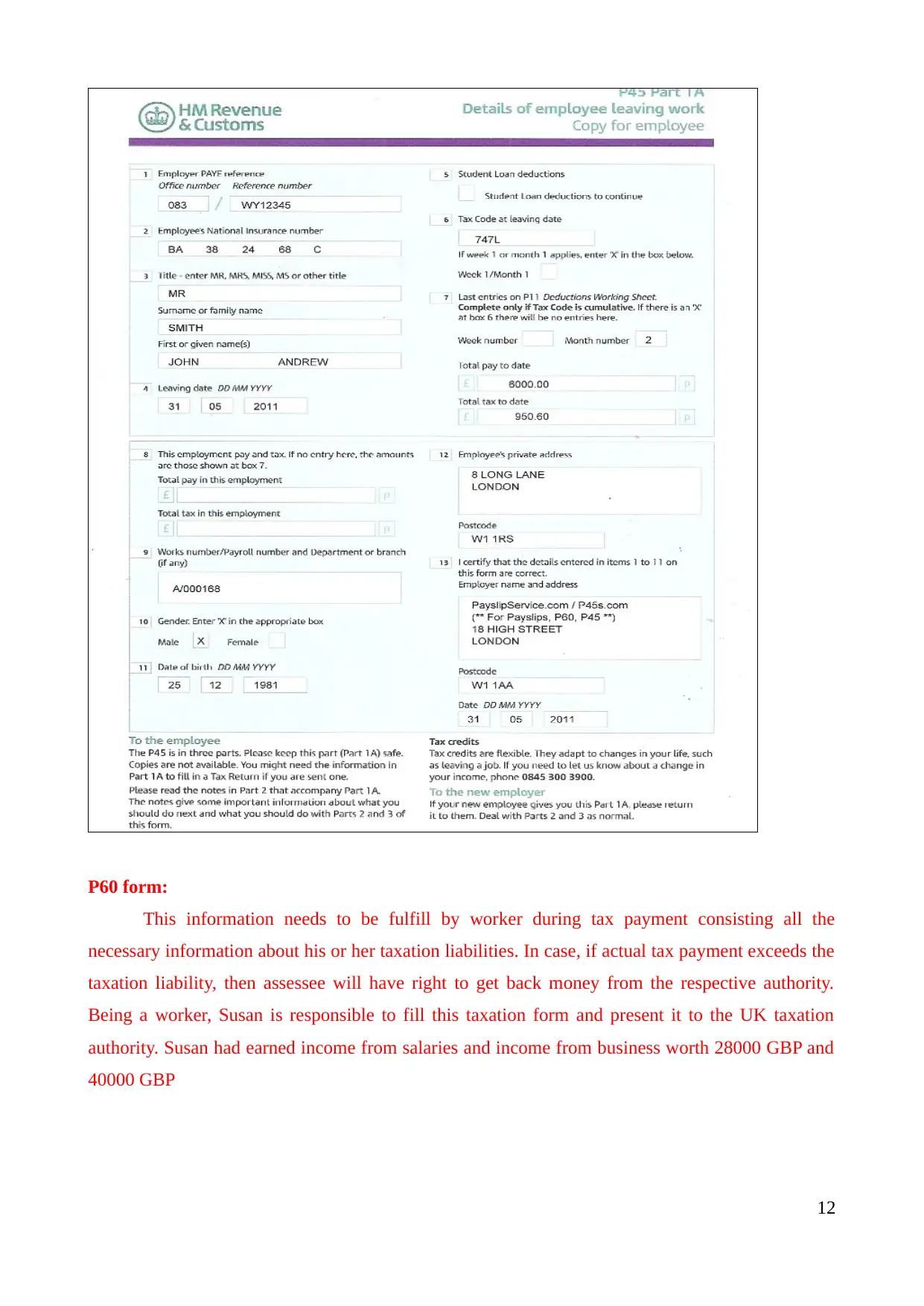
P60 form:
This information needs to be fulfill by worker during tax payment consisting all the
necessary information about his or her taxation liabilities. In case, if actual tax payment exceeds the
taxation liability, then assessee will have right to get back money from the respective authority.
Being a worker, Susan is responsible to fill this taxation form and present it to the UK taxation
authority. Susan had earned income from salaries and income from business worth 28000 GBP and
40000 GBP
12
This information needs to be fulfill by worker during tax payment consisting all the
necessary information about his or her taxation liabilities. In case, if actual tax payment exceeds the
taxation liability, then assessee will have right to get back money from the respective authority.
Being a worker, Susan is responsible to fill this taxation form and present it to the UK taxation
authority. Susan had earned income from salaries and income from business worth 28000 GBP and
40000 GBP
12

P11D form:
In case when employer provides any benefits in kind to their workers then they need to fill
this form and present it to tax authority. It is needed to be fulfilled when the value of BIK exceeds
limit of 8500 GBP in any financial year, presented hereunder:
13
In case when employer provides any benefits in kind to their workers then they need to fill
this form and present it to tax authority. It is needed to be fulfilled when the value of BIK exceeds
limit of 8500 GBP in any financial year, presented hereunder:
13
Paraphrase This Document
Need a fresh take? Get an instant paraphrase of this document with our AI Paraphraser
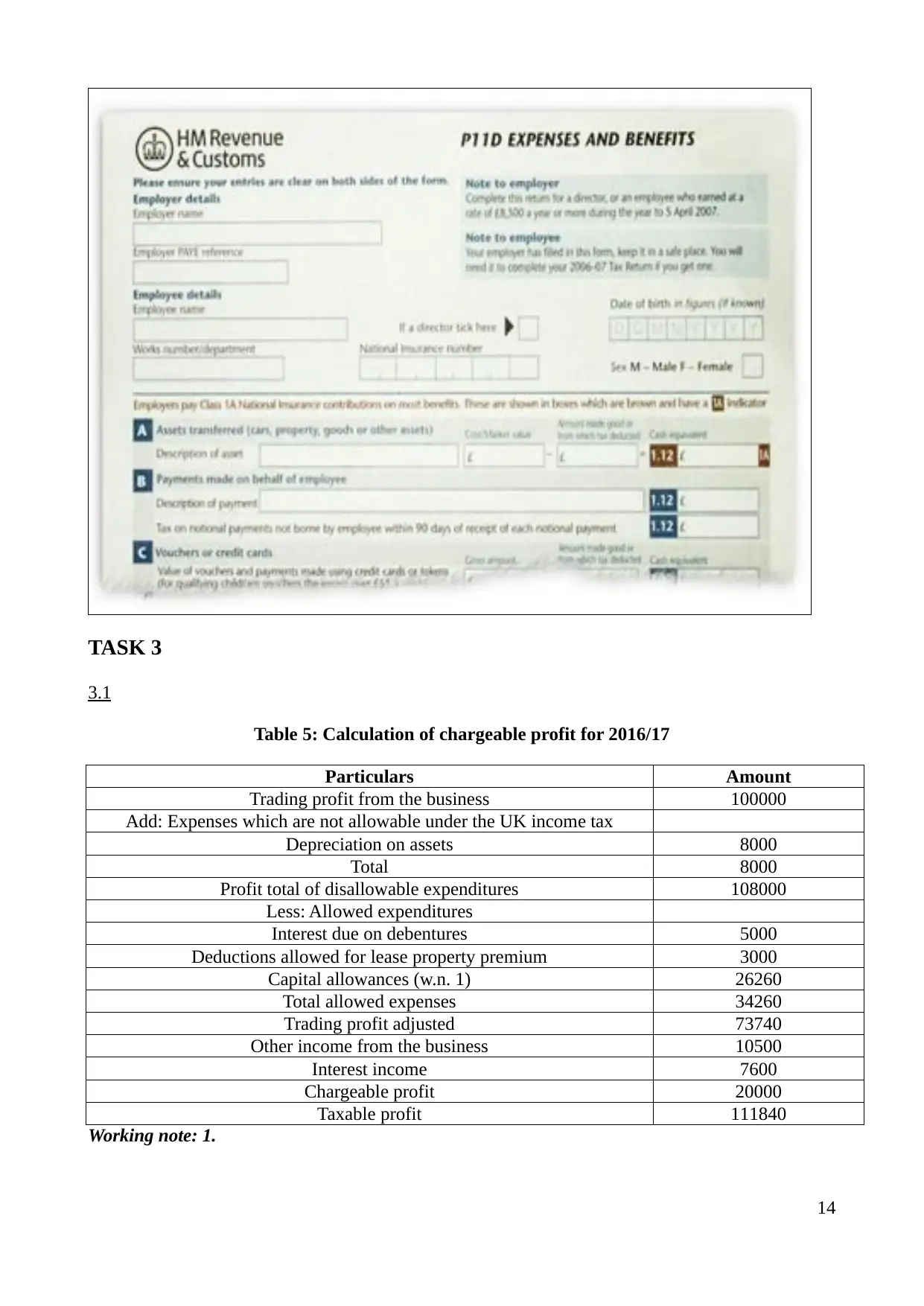
TASK 3
3.1
Table 5: Calculation of chargeable profit for 2016/17
Particulars Amount
Trading profit from the business 100000
Add: Expenses which are not allowable under the UK income tax
Depreciation on assets 8000
Total 8000
Profit total of disallowable expenditures 108000
Less: Allowed expenditures
Interest due on debentures 5000
Deductions allowed for lease property premium 3000
Capital allowances (w.n. 1) 26260
Total allowed expenses 34260
Trading profit adjusted 73740
Other income from the business 10500
Interest income 7600
Chargeable profit 20000
Taxable profit 111840
Working note: 1.
14
3.1
Table 5: Calculation of chargeable profit for 2016/17
Particulars Amount
Trading profit from the business 100000
Add: Expenses which are not allowable under the UK income tax
Depreciation on assets 8000
Total 8000
Profit total of disallowable expenditures 108000
Less: Allowed expenditures
Interest due on debentures 5000
Deductions allowed for lease property premium 3000
Capital allowances (w.n. 1) 26260
Total allowed expenses 34260
Trading profit adjusted 73740
Other income from the business 10500
Interest income 7600
Chargeable profit 20000
Taxable profit 111840
Working note: 1.
14
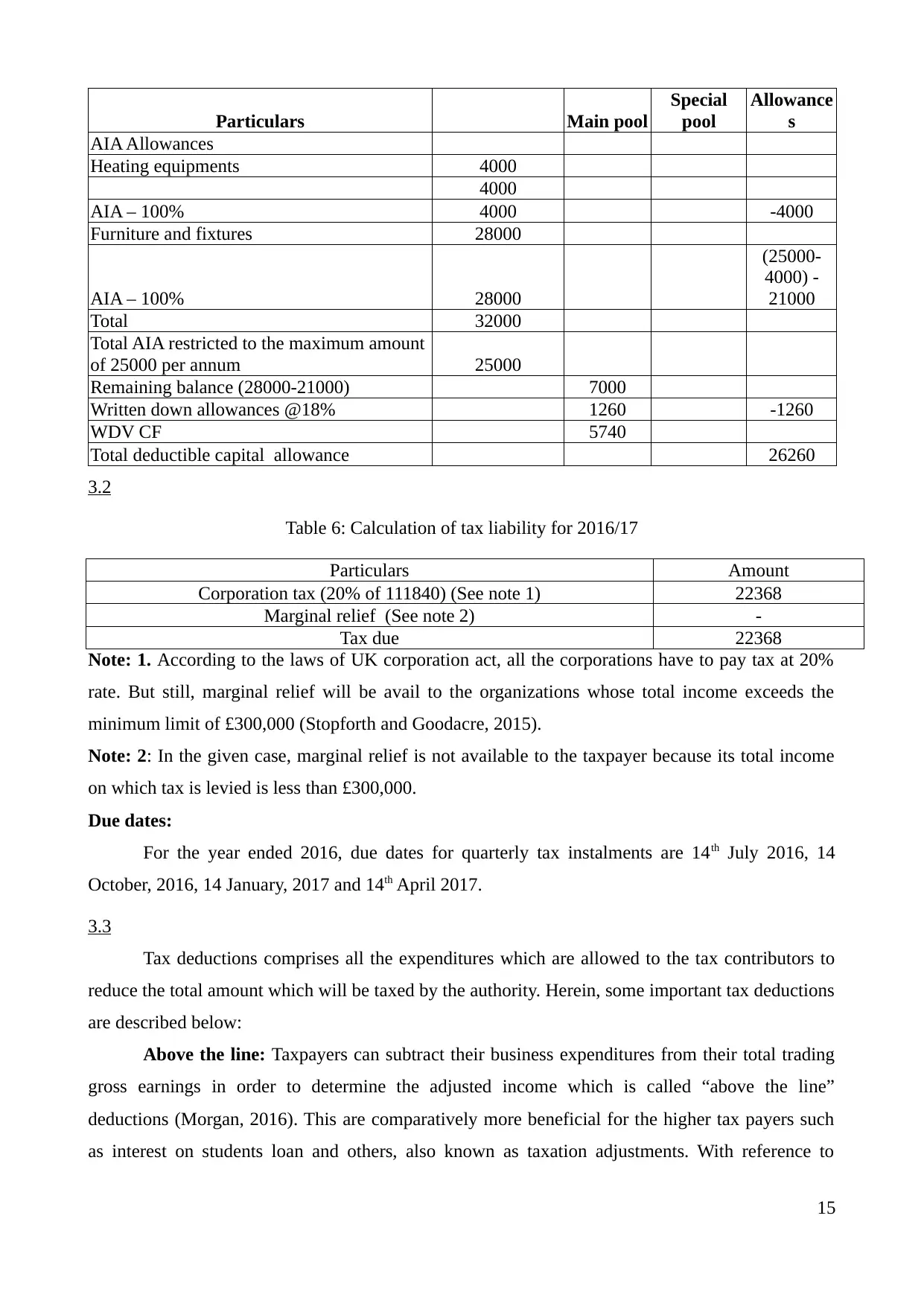
Particulars Main pool
Special
pool
Allowance
s
AIA Allowances
Heating equipments 4000
4000
AIA – 100% 4000 -4000
Furniture and fixtures 28000
AIA – 100% 28000
(25000-
4000) -
21000
Total 32000
Total AIA restricted to the maximum amount
of 25000 per annum 25000
Remaining balance (28000-21000) 7000
Written down allowances @18% 1260 -1260
WDV CF 5740
Total deductible capital allowance 26260
3.2
Table 6: Calculation of tax liability for 2016/17
Particulars Amount
Corporation tax (20% of 111840) (See note 1) 22368
Marginal relief (See note 2) -
Tax due 22368
Note: 1. According to the laws of UK corporation act, all the corporations have to pay tax at 20%
rate. But still, marginal relief will be avail to the organizations whose total income exceeds the
minimum limit of £300,000 (Stopforth and Goodacre, 2015).
Note: 2: In the given case, marginal relief is not available to the taxpayer because its total income
on which tax is levied is less than £300,000.
Due dates:
For the year ended 2016, due dates for quarterly tax instalments are 14th July 2016, 14
October, 2016, 14 January, 2017 and 14th April 2017.
3.3
Tax deductions comprises all the expenditures which are allowed to the tax contributors to
reduce the total amount which will be taxed by the authority. Herein, some important tax deductions
are described below:
Above the line: Taxpayers can subtract their business expenditures from their total trading
gross earnings in order to determine the adjusted income which is called “above the line”
deductions (Morgan, 2016). This are comparatively more beneficial for the higher tax payers such
as interest on students loan and others, also known as taxation adjustments. With reference to
15
Special
pool
Allowance
s
AIA Allowances
Heating equipments 4000
4000
AIA – 100% 4000 -4000
Furniture and fixtures 28000
AIA – 100% 28000
(25000-
4000) -
21000
Total 32000
Total AIA restricted to the maximum amount
of 25000 per annum 25000
Remaining balance (28000-21000) 7000
Written down allowances @18% 1260 -1260
WDV CF 5740
Total deductible capital allowance 26260
3.2
Table 6: Calculation of tax liability for 2016/17
Particulars Amount
Corporation tax (20% of 111840) (See note 1) 22368
Marginal relief (See note 2) -
Tax due 22368
Note: 1. According to the laws of UK corporation act, all the corporations have to pay tax at 20%
rate. But still, marginal relief will be avail to the organizations whose total income exceeds the
minimum limit of £300,000 (Stopforth and Goodacre, 2015).
Note: 2: In the given case, marginal relief is not available to the taxpayer because its total income
on which tax is levied is less than £300,000.
Due dates:
For the year ended 2016, due dates for quarterly tax instalments are 14th July 2016, 14
October, 2016, 14 January, 2017 and 14th April 2017.
3.3
Tax deductions comprises all the expenditures which are allowed to the tax contributors to
reduce the total amount which will be taxed by the authority. Herein, some important tax deductions
are described below:
Above the line: Taxpayers can subtract their business expenditures from their total trading
gross earnings in order to determine the adjusted income which is called “above the line”
deductions (Morgan, 2016). This are comparatively more beneficial for the higher tax payers such
as interest on students loan and others, also known as taxation adjustments. With reference to
15
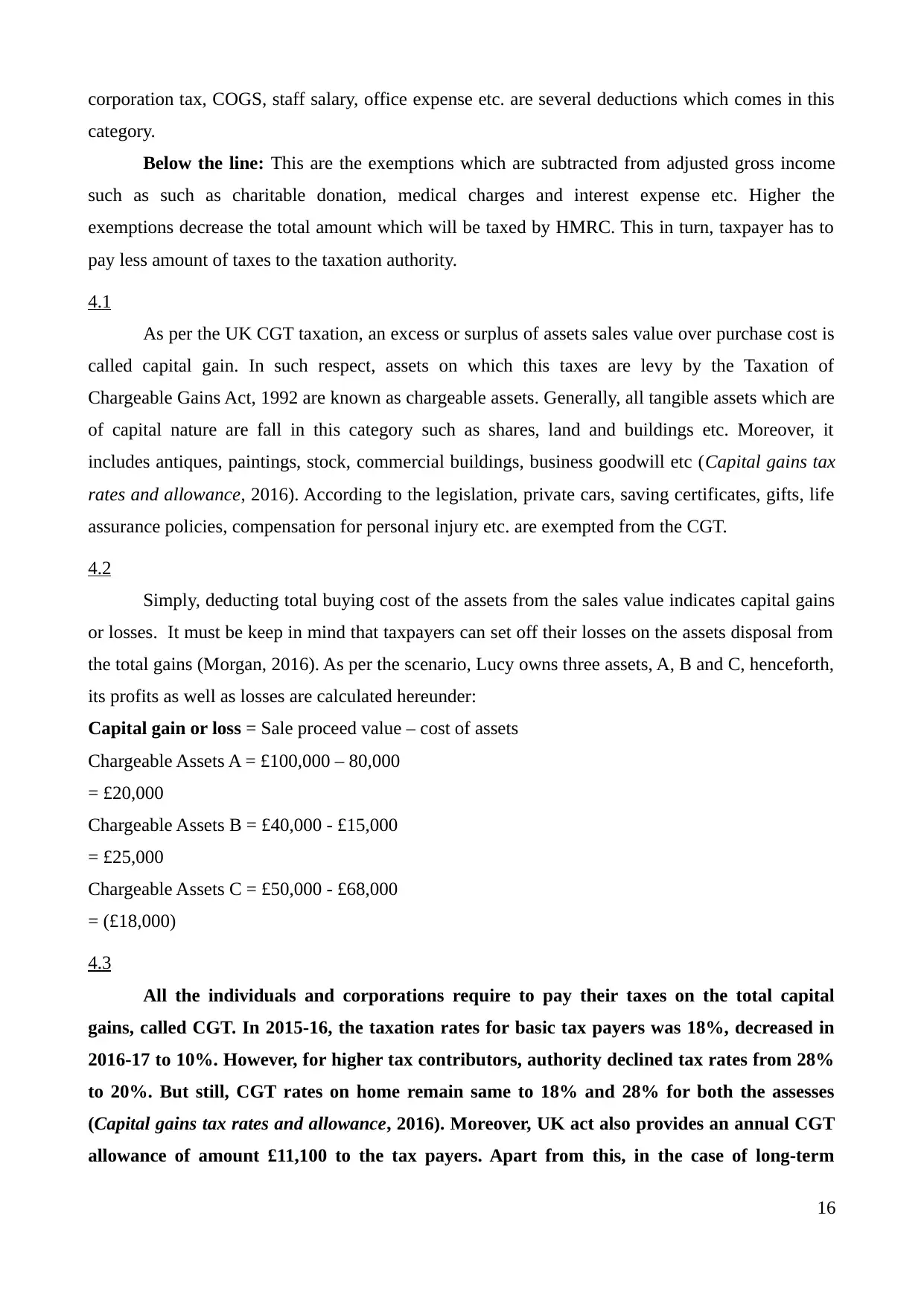
corporation tax, COGS, staff salary, office expense etc. are several deductions which comes in this
category.
Below the line: This are the exemptions which are subtracted from adjusted gross income
such as such as charitable donation, medical charges and interest expense etc. Higher the
exemptions decrease the total amount which will be taxed by HMRC. This in turn, taxpayer has to
pay less amount of taxes to the taxation authority.
4.1
As per the UK CGT taxation, an excess or surplus of assets sales value over purchase cost is
called capital gain. In such respect, assets on which this taxes are levy by the Taxation of
Chargeable Gains Act, 1992 are known as chargeable assets. Generally, all tangible assets which are
of capital nature are fall in this category such as shares, land and buildings etc. Moreover, it
includes antiques, paintings, stock, commercial buildings, business goodwill etc (Capital gains tax
rates and allowance, 2016). According to the legislation, private cars, saving certificates, gifts, life
assurance policies, compensation for personal injury etc. are exempted from the CGT.
4.2
Simply, deducting total buying cost of the assets from the sales value indicates capital gains
or losses. It must be keep in mind that taxpayers can set off their losses on the assets disposal from
the total gains (Morgan, 2016). As per the scenario, Lucy owns three assets, A, B and C, henceforth,
its profits as well as losses are calculated hereunder:
Capital gain or loss = Sale proceed value – cost of assets
Chargeable Assets A = £100,000 – 80,000
= £20,000
Chargeable Assets B = £40,000 - £15,000
= £25,000
Chargeable Assets C = £50,000 - £68,000
= (£18,000)
4.3
All the individuals and corporations require to pay their taxes on the total capital
gains, called CGT. In 2015-16, the taxation rates for basic tax payers was 18%, decreased in
2016-17 to 10%. However, for higher tax contributors, authority declined tax rates from 28%
to 20%. But still, CGT rates on home remain same to 18% and 28% for both the assesses
(Capital gains tax rates and allowance, 2016). Moreover, UK act also provides an annual CGT
allowance of amount £11,100 to the tax payers. Apart from this, in the case of long-term
16
category.
Below the line: This are the exemptions which are subtracted from adjusted gross income
such as such as charitable donation, medical charges and interest expense etc. Higher the
exemptions decrease the total amount which will be taxed by HMRC. This in turn, taxpayer has to
pay less amount of taxes to the taxation authority.
4.1
As per the UK CGT taxation, an excess or surplus of assets sales value over purchase cost is
called capital gain. In such respect, assets on which this taxes are levy by the Taxation of
Chargeable Gains Act, 1992 are known as chargeable assets. Generally, all tangible assets which are
of capital nature are fall in this category such as shares, land and buildings etc. Moreover, it
includes antiques, paintings, stock, commercial buildings, business goodwill etc (Capital gains tax
rates and allowance, 2016). According to the legislation, private cars, saving certificates, gifts, life
assurance policies, compensation for personal injury etc. are exempted from the CGT.
4.2
Simply, deducting total buying cost of the assets from the sales value indicates capital gains
or losses. It must be keep in mind that taxpayers can set off their losses on the assets disposal from
the total gains (Morgan, 2016). As per the scenario, Lucy owns three assets, A, B and C, henceforth,
its profits as well as losses are calculated hereunder:
Capital gain or loss = Sale proceed value – cost of assets
Chargeable Assets A = £100,000 – 80,000
= £20,000
Chargeable Assets B = £40,000 - £15,000
= £25,000
Chargeable Assets C = £50,000 - £68,000
= (£18,000)
4.3
All the individuals and corporations require to pay their taxes on the total capital
gains, called CGT. In 2015-16, the taxation rates for basic tax payers was 18%, decreased in
2016-17 to 10%. However, for higher tax contributors, authority declined tax rates from 28%
to 20%. But still, CGT rates on home remain same to 18% and 28% for both the assesses
(Capital gains tax rates and allowance, 2016). Moreover, UK act also provides an annual CGT
allowance of amount £11,100 to the tax payers. Apart from this, in the case of long-term
16
Secure Best Marks with AI Grader
Need help grading? Try our AI Grader for instant feedback on your assignments.
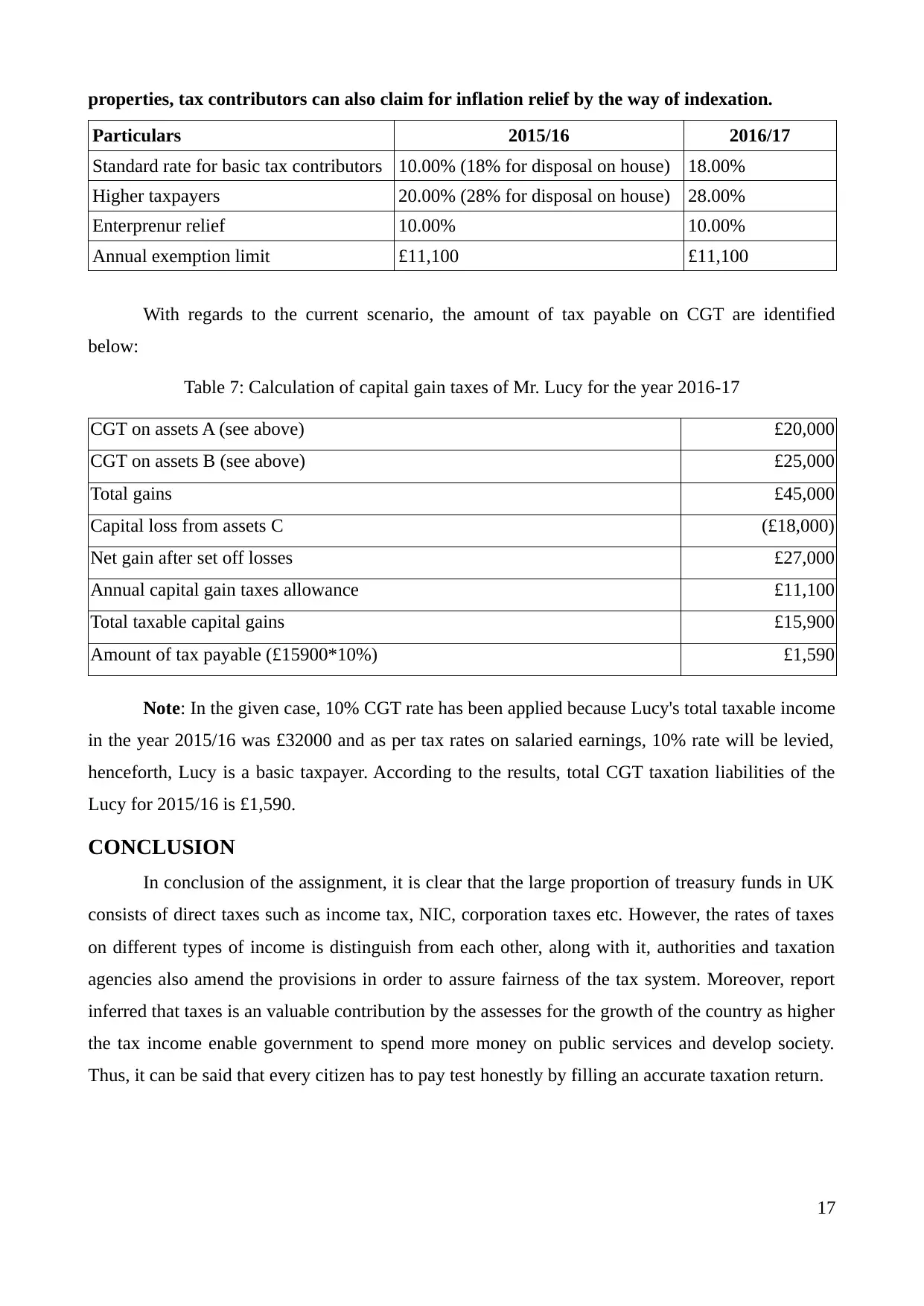
properties, tax contributors can also claim for inflation relief by the way of indexation.
Particulars 2015/16 2016/17
Standard rate for basic tax contributors 10.00% (18% for disposal on house) 18.00%
Higher taxpayers 20.00% (28% for disposal on house) 28.00%
Enterprenur relief 10.00% 10.00%
Annual exemption limit £11,100 £11,100
With regards to the current scenario, the amount of tax payable on CGT are identified
below:
Table 7: Calculation of capital gain taxes of Mr. Lucy for the year 2016-17
CGT on assets A (see above) £20,000
CGT on assets B (see above) £25,000
Total gains £45,000
Capital loss from assets C (£18,000)
Net gain after set off losses £27,000
Annual capital gain taxes allowance £11,100
Total taxable capital gains £15,900
Amount of tax payable (£15900*10%) £1,590
Note: In the given case, 10% CGT rate has been applied because Lucy's total taxable income
in the year 2015/16 was £32000 and as per tax rates on salaried earnings, 10% rate will be levied,
henceforth, Lucy is a basic taxpayer. According to the results, total CGT taxation liabilities of the
Lucy for 2015/16 is £1,590.
CONCLUSION
In conclusion of the assignment, it is clear that the large proportion of treasury funds in UK
consists of direct taxes such as income tax, NIC, corporation taxes etc. However, the rates of taxes
on different types of income is distinguish from each other, along with it, authorities and taxation
agencies also amend the provisions in order to assure fairness of the tax system. Moreover, report
inferred that taxes is an valuable contribution by the assesses for the growth of the country as higher
the tax income enable government to spend more money on public services and develop society.
Thus, it can be said that every citizen has to pay test honestly by filling an accurate taxation return.
17
Particulars 2015/16 2016/17
Standard rate for basic tax contributors 10.00% (18% for disposal on house) 18.00%
Higher taxpayers 20.00% (28% for disposal on house) 28.00%
Enterprenur relief 10.00% 10.00%
Annual exemption limit £11,100 £11,100
With regards to the current scenario, the amount of tax payable on CGT are identified
below:
Table 7: Calculation of capital gain taxes of Mr. Lucy for the year 2016-17
CGT on assets A (see above) £20,000
CGT on assets B (see above) £25,000
Total gains £45,000
Capital loss from assets C (£18,000)
Net gain after set off losses £27,000
Annual capital gain taxes allowance £11,100
Total taxable capital gains £15,900
Amount of tax payable (£15900*10%) £1,590
Note: In the given case, 10% CGT rate has been applied because Lucy's total taxable income
in the year 2015/16 was £32000 and as per tax rates on salaried earnings, 10% rate will be levied,
henceforth, Lucy is a basic taxpayer. According to the results, total CGT taxation liabilities of the
Lucy for 2015/16 is £1,590.
CONCLUSION
In conclusion of the assignment, it is clear that the large proportion of treasury funds in UK
consists of direct taxes such as income tax, NIC, corporation taxes etc. However, the rates of taxes
on different types of income is distinguish from each other, along with it, authorities and taxation
agencies also amend the provisions in order to assure fairness of the tax system. Moreover, report
inferred that taxes is an valuable contribution by the assesses for the growth of the country as higher
the tax income enable government to spend more money on public services and develop society.
Thus, it can be said that every citizen has to pay test honestly by filling an accurate taxation return.
17
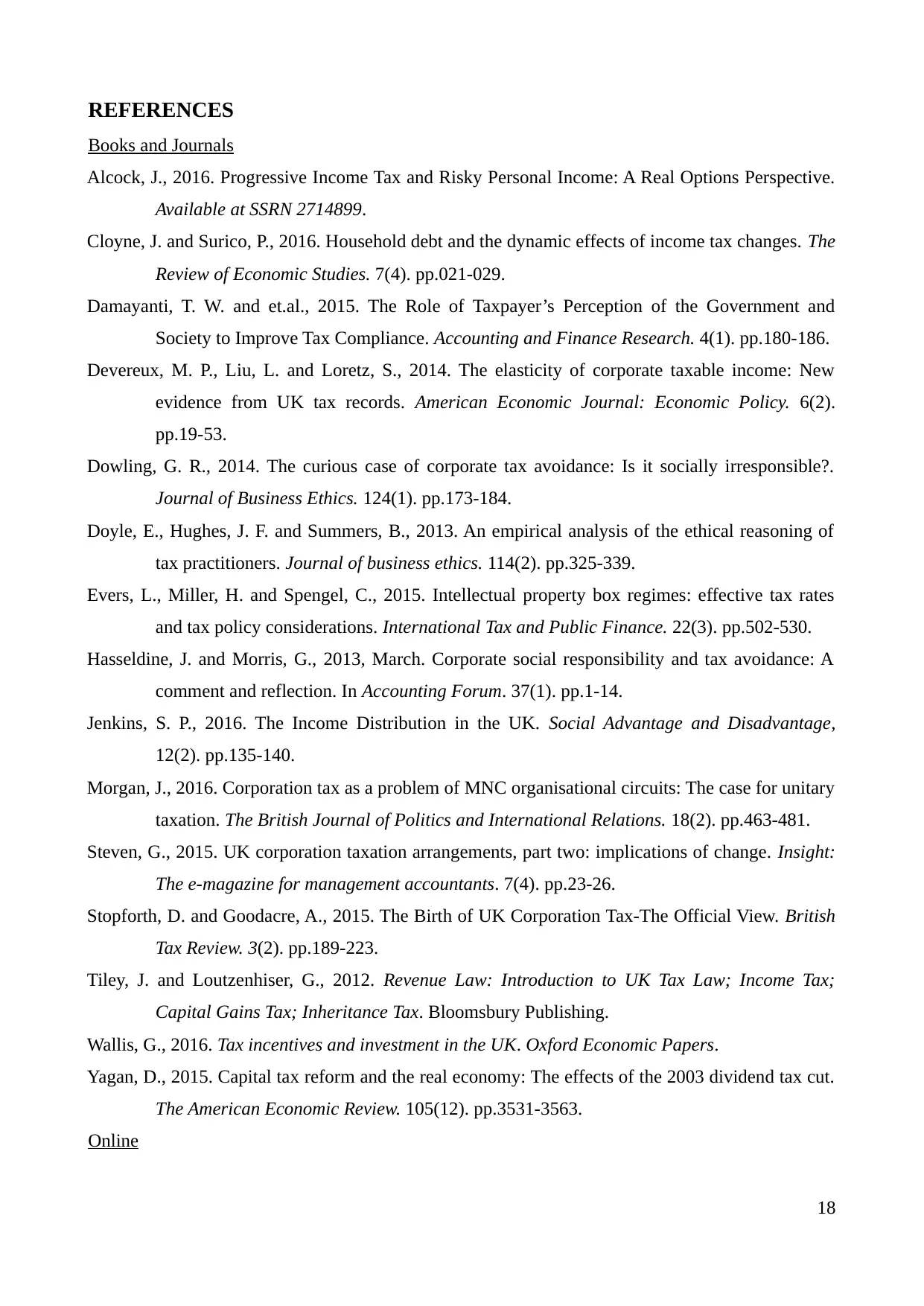
REFERENCES
Books and Journals
Alcock, J., 2016. Progressive Income Tax and Risky Personal Income: A Real Options Perspective.
Available at SSRN 2714899.
Cloyne, J. and Surico, P., 2016. Household debt and the dynamic effects of income tax changes. The
Review of Economic Studies. 7(4). pp.021-029.
Damayanti, T. W. and et.al., 2015. The Role of Taxpayer’s Perception of the Government and
Society to Improve Tax Compliance. Accounting and Finance Research. 4(1). pp.180-186.
Devereux, M. P., Liu, L. and Loretz, S., 2014. The elasticity of corporate taxable income: New
evidence from UK tax records. American Economic Journal: Economic Policy. 6(2).
pp.19-53.
Dowling, G. R., 2014. The curious case of corporate tax avoidance: Is it socially irresponsible?.
Journal of Business Ethics. 124(1). pp.173-184.
Doyle, E., Hughes, J. F. and Summers, B., 2013. An empirical analysis of the ethical reasoning of
tax practitioners. Journal of business ethics. 114(2). pp.325-339.
Evers, L., Miller, H. and Spengel, C., 2015. Intellectual property box regimes: effective tax rates
and tax policy considerations. International Tax and Public Finance. 22(3). pp.502-530.
Hasseldine, J. and Morris, G., 2013, March. Corporate social responsibility and tax avoidance: A
comment and reflection. In Accounting Forum. 37(1). pp.1-14.
Jenkins, S. P., 2016. The Income Distribution in the UK. Social Advantage and Disadvantage,
12(2). pp.135-140.
Morgan, J., 2016. Corporation tax as a problem of MNC organisational circuits: The case for unitary
taxation. The British Journal of Politics and International Relations. 18(2). pp.463-481.
Steven, G., 2015. UK corporation taxation arrangements, part two: implications of change. Insight:
The e-magazine for management accountants. 7(4). pp.23-26.
Stopforth, D. and Goodacre, A., 2015. The Birth of UK Corporation Tax-The Official View. British
Tax Review. 3(2). pp.189-223.
Tiley, J. and Loutzenhiser, G., 2012. Revenue Law: Introduction to UK Tax Law; Income Tax;
Capital Gains Tax; Inheritance Tax. Bloomsbury Publishing.
Wallis, G., 2016. Tax incentives and investment in the UK. Oxford Economic Papers.
Yagan, D., 2015. Capital tax reform and the real economy: The effects of the 2003 dividend tax cut.
The American Economic Review. 105(12). pp.3531-3563.
Online
18
Books and Journals
Alcock, J., 2016. Progressive Income Tax and Risky Personal Income: A Real Options Perspective.
Available at SSRN 2714899.
Cloyne, J. and Surico, P., 2016. Household debt and the dynamic effects of income tax changes. The
Review of Economic Studies. 7(4). pp.021-029.
Damayanti, T. W. and et.al., 2015. The Role of Taxpayer’s Perception of the Government and
Society to Improve Tax Compliance. Accounting and Finance Research. 4(1). pp.180-186.
Devereux, M. P., Liu, L. and Loretz, S., 2014. The elasticity of corporate taxable income: New
evidence from UK tax records. American Economic Journal: Economic Policy. 6(2).
pp.19-53.
Dowling, G. R., 2014. The curious case of corporate tax avoidance: Is it socially irresponsible?.
Journal of Business Ethics. 124(1). pp.173-184.
Doyle, E., Hughes, J. F. and Summers, B., 2013. An empirical analysis of the ethical reasoning of
tax practitioners. Journal of business ethics. 114(2). pp.325-339.
Evers, L., Miller, H. and Spengel, C., 2015. Intellectual property box regimes: effective tax rates
and tax policy considerations. International Tax and Public Finance. 22(3). pp.502-530.
Hasseldine, J. and Morris, G., 2013, March. Corporate social responsibility and tax avoidance: A
comment and reflection. In Accounting Forum. 37(1). pp.1-14.
Jenkins, S. P., 2016. The Income Distribution in the UK. Social Advantage and Disadvantage,
12(2). pp.135-140.
Morgan, J., 2016. Corporation tax as a problem of MNC organisational circuits: The case for unitary
taxation. The British Journal of Politics and International Relations. 18(2). pp.463-481.
Steven, G., 2015. UK corporation taxation arrangements, part two: implications of change. Insight:
The e-magazine for management accountants. 7(4). pp.23-26.
Stopforth, D. and Goodacre, A., 2015. The Birth of UK Corporation Tax-The Official View. British
Tax Review. 3(2). pp.189-223.
Tiley, J. and Loutzenhiser, G., 2012. Revenue Law: Introduction to UK Tax Law; Income Tax;
Capital Gains Tax; Inheritance Tax. Bloomsbury Publishing.
Wallis, G., 2016. Tax incentives and investment in the UK. Oxford Economic Papers.
Yagan, D., 2015. Capital tax reform and the real economy: The effects of the 2003 dividend tax cut.
The American Economic Review. 105(12). pp.3531-3563.
Online
18
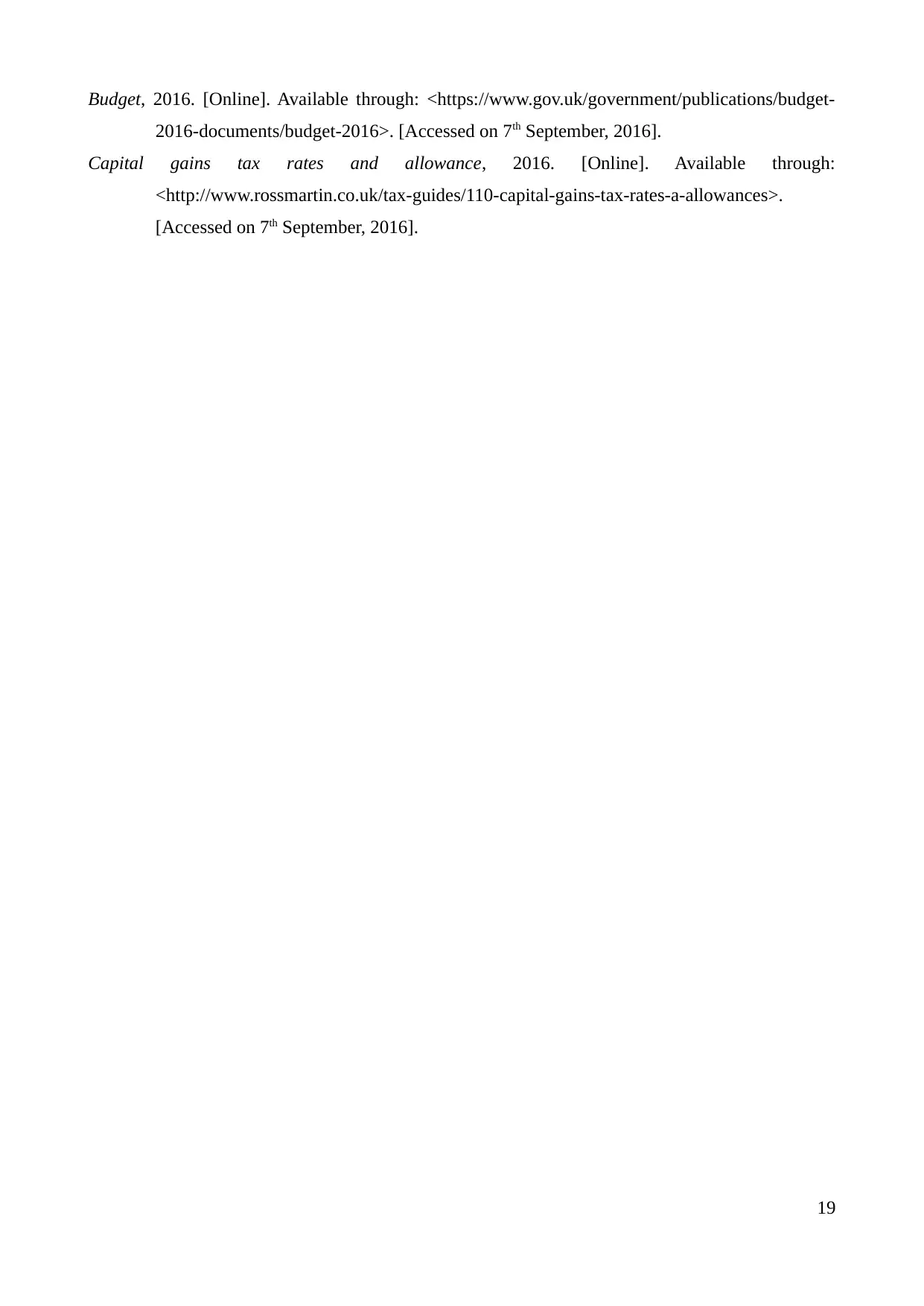
Budget, 2016. [Online]. Available through: <https://www.gov.uk/government/publications/budget-
2016-documents/budget-2016>. [Accessed on 7th September, 2016].
Capital gains tax rates and allowance, 2016. [Online]. Available through:
<http://www.rossmartin.co.uk/tax-guides/110-capital-gains-tax-rates-a-allowances>.
[Accessed on 7th September, 2016].
19
2016-documents/budget-2016>. [Accessed on 7th September, 2016].
Capital gains tax rates and allowance, 2016. [Online]. Available through:
<http://www.rossmartin.co.uk/tax-guides/110-capital-gains-tax-rates-a-allowances>.
[Accessed on 7th September, 2016].
19
1 out of 19
Related Documents
Your All-in-One AI-Powered Toolkit for Academic Success.
+13062052269
info@desklib.com
Available 24*7 on WhatsApp / Email
![[object Object]](/_next/static/media/star-bottom.7253800d.svg)
Unlock your academic potential
© 2024 | Zucol Services PVT LTD | All rights reserved.





